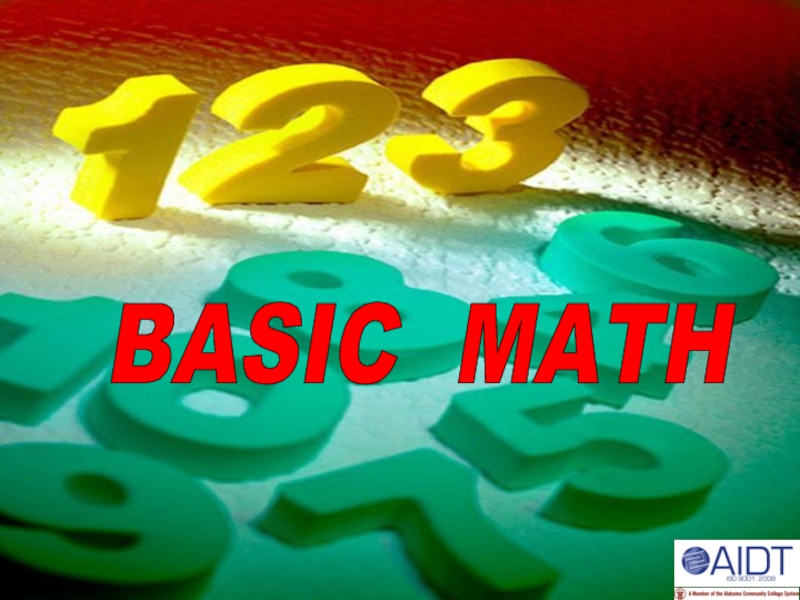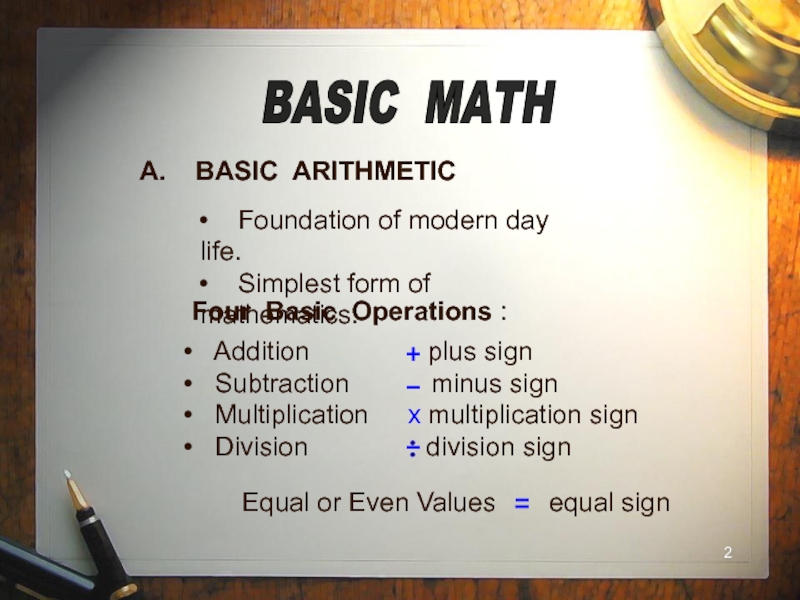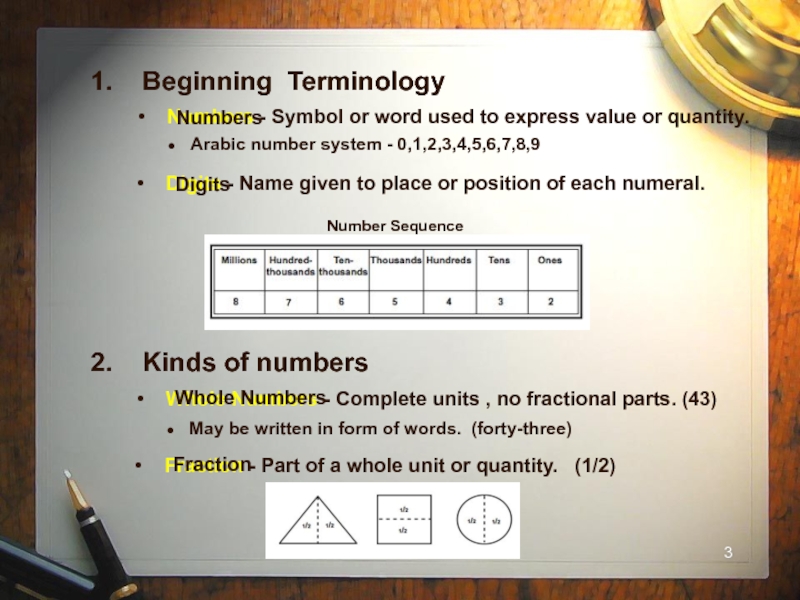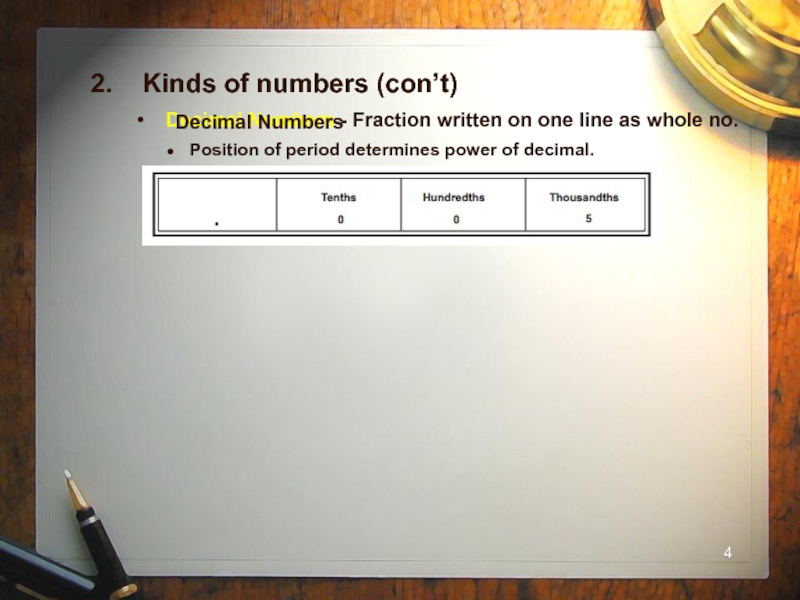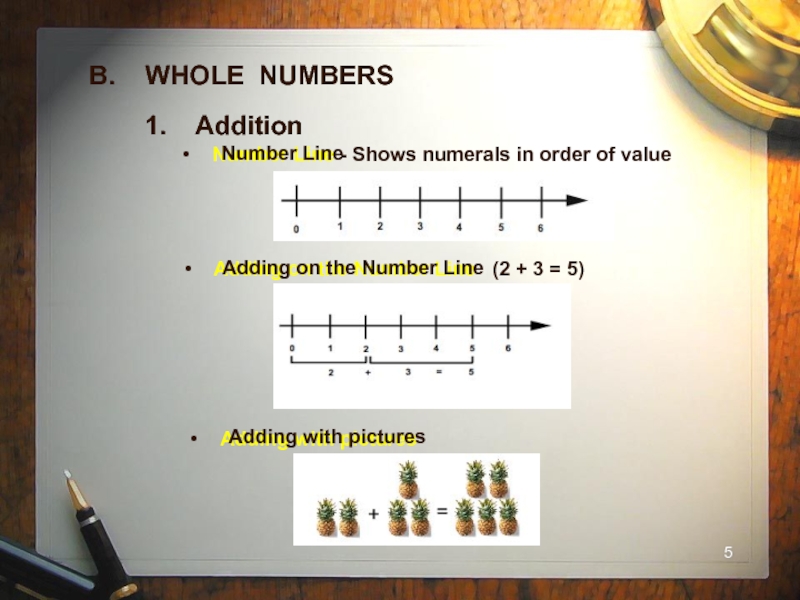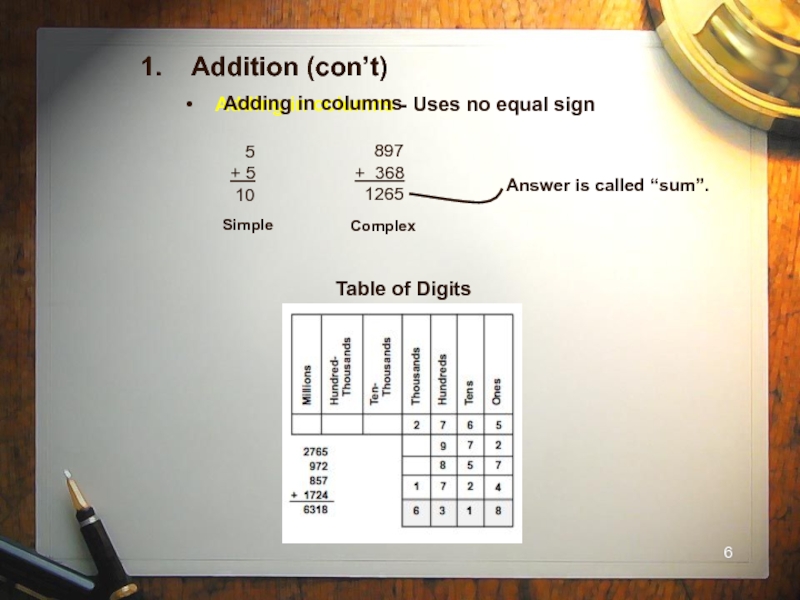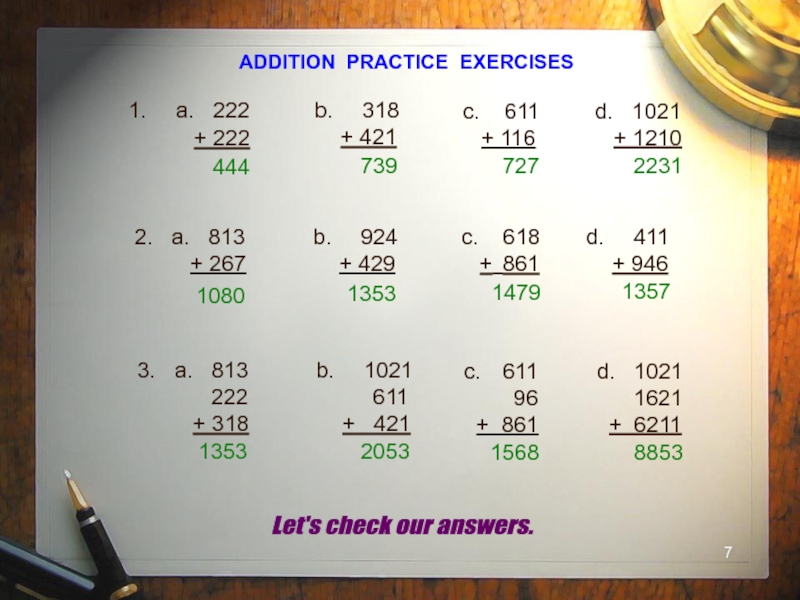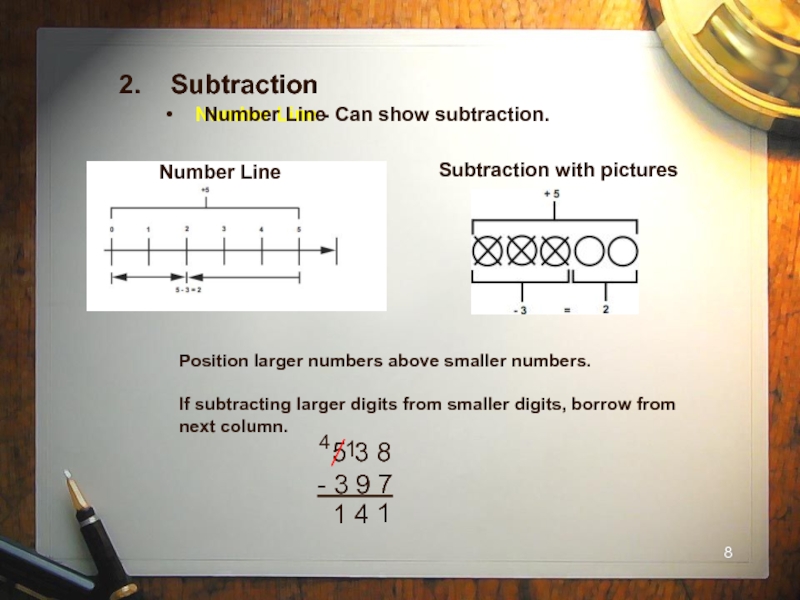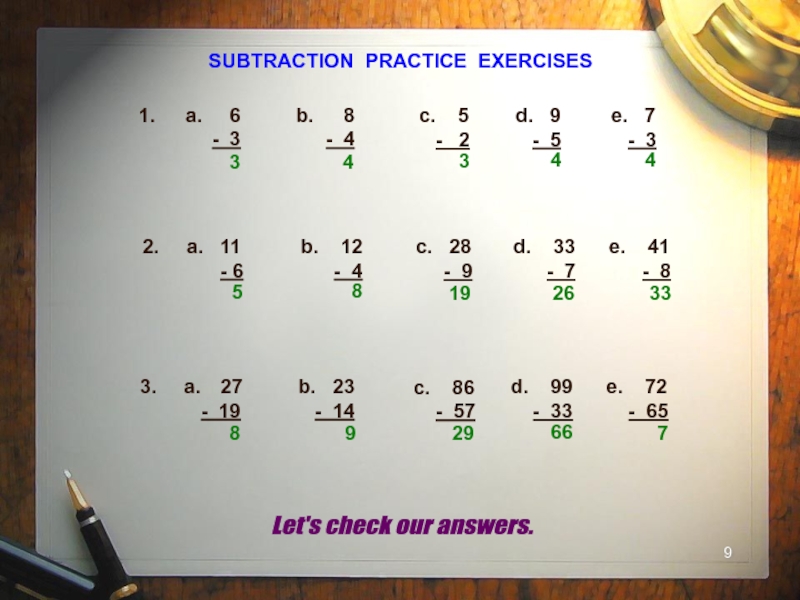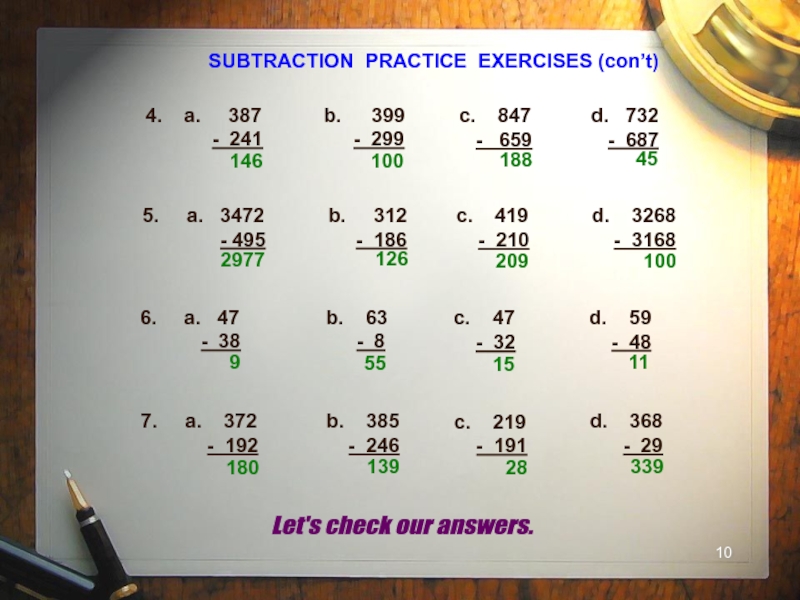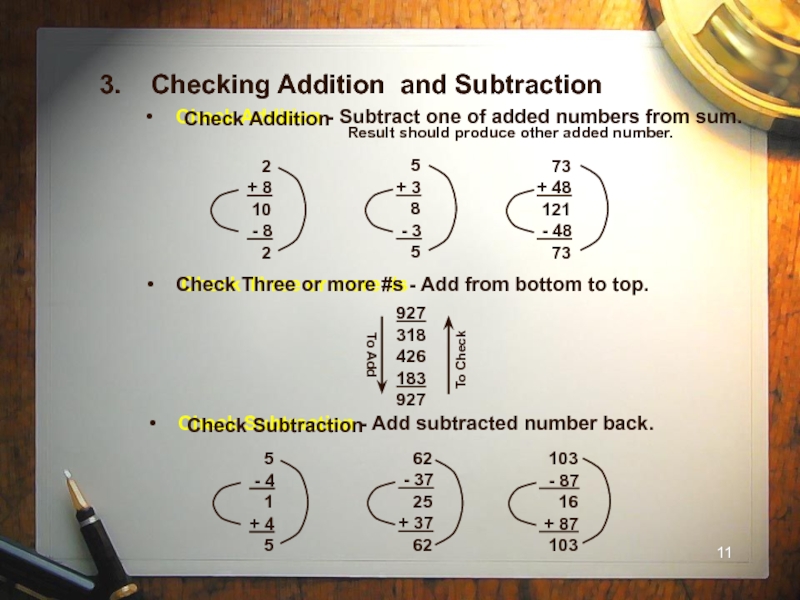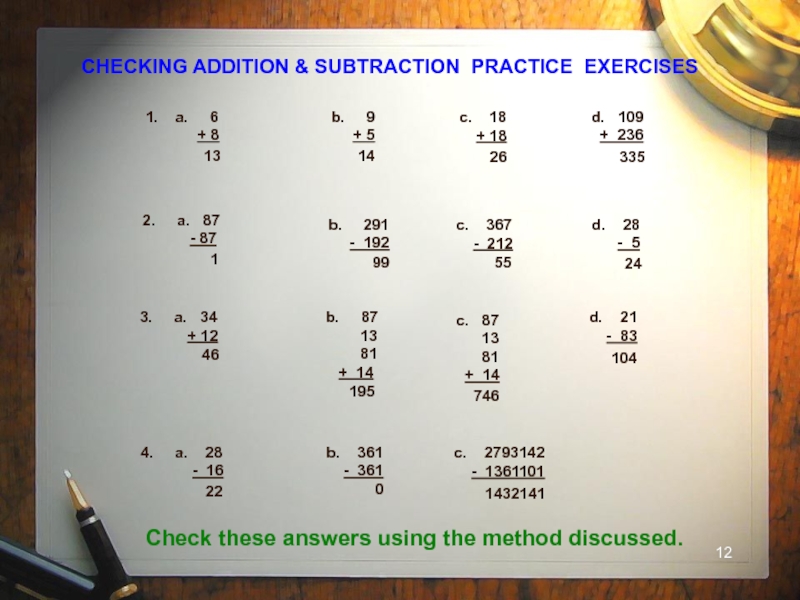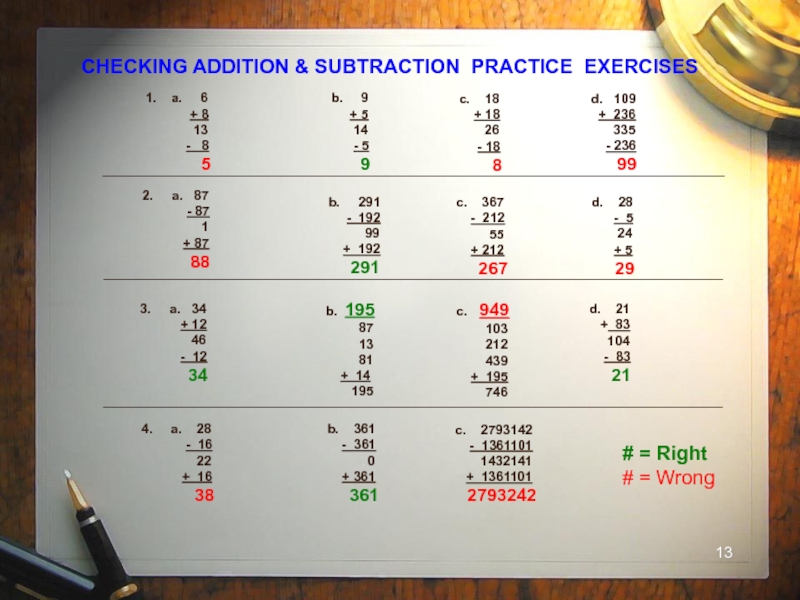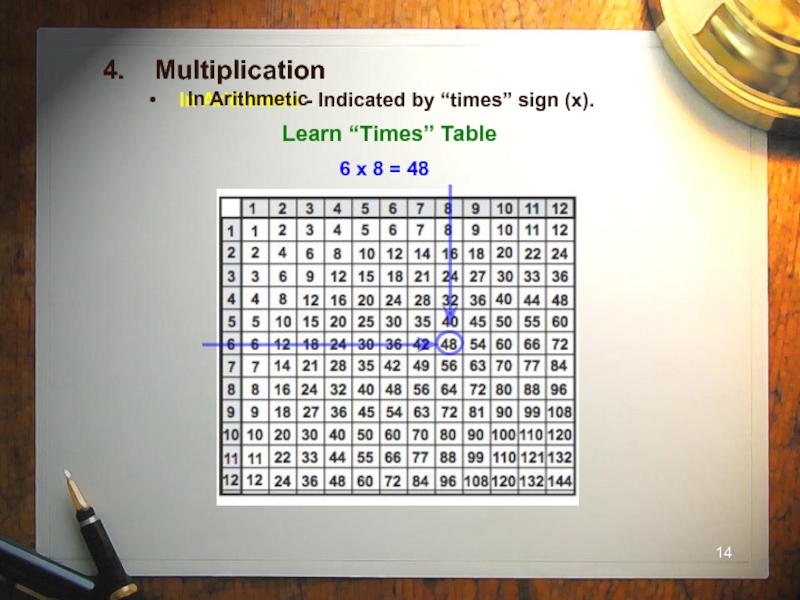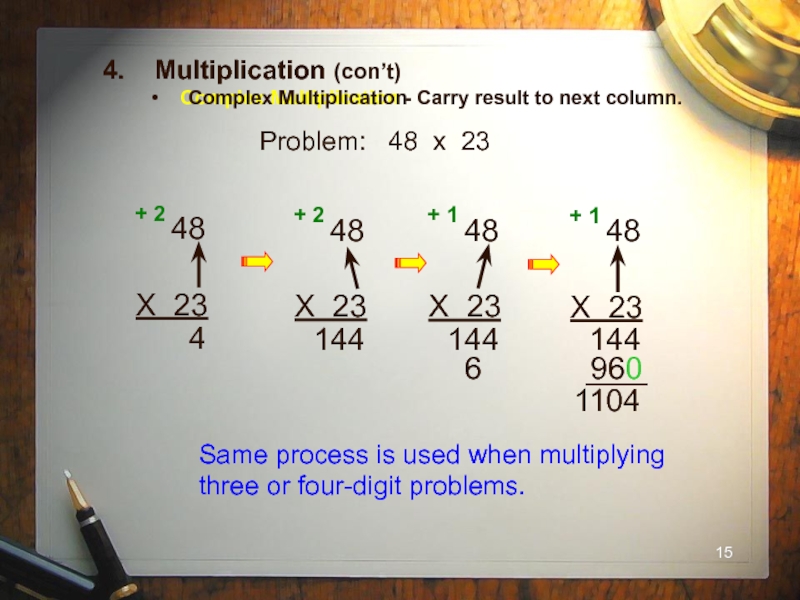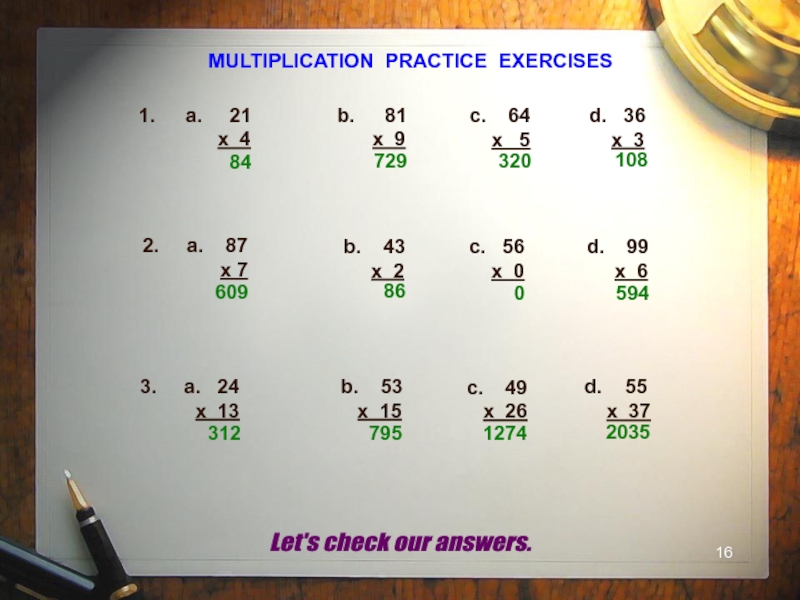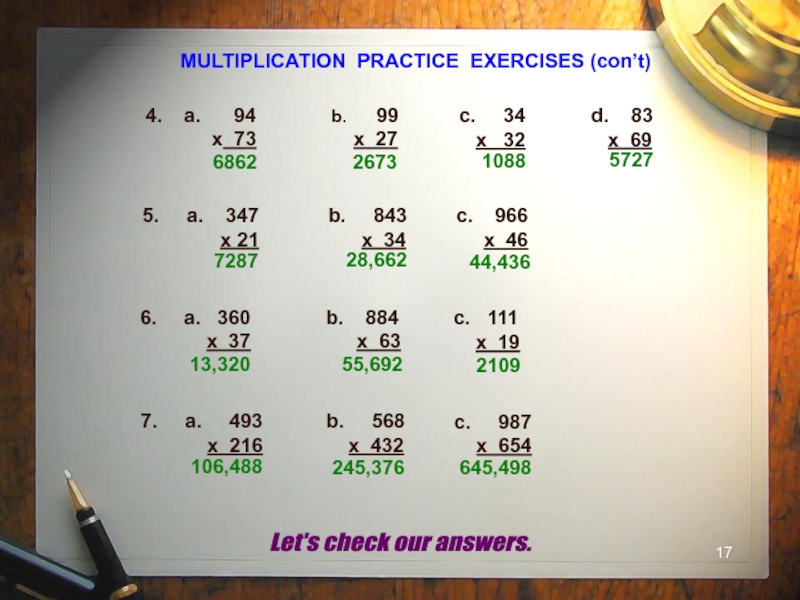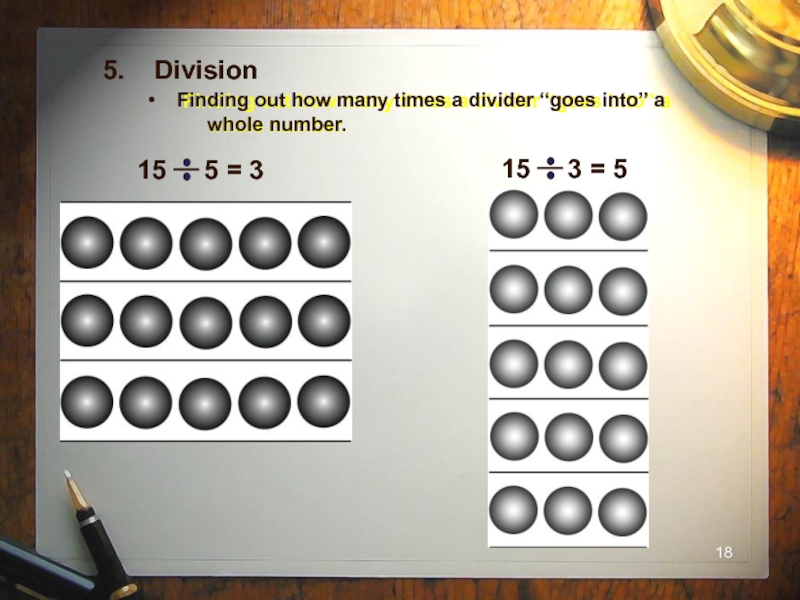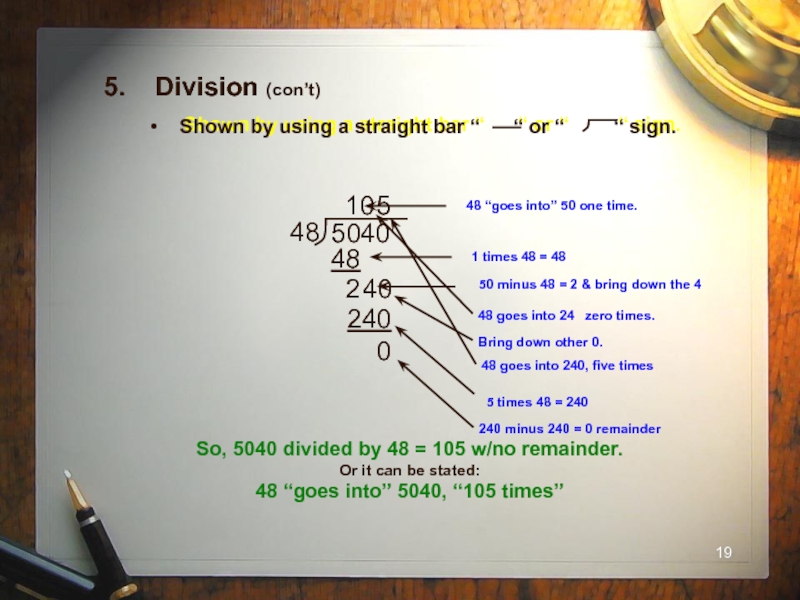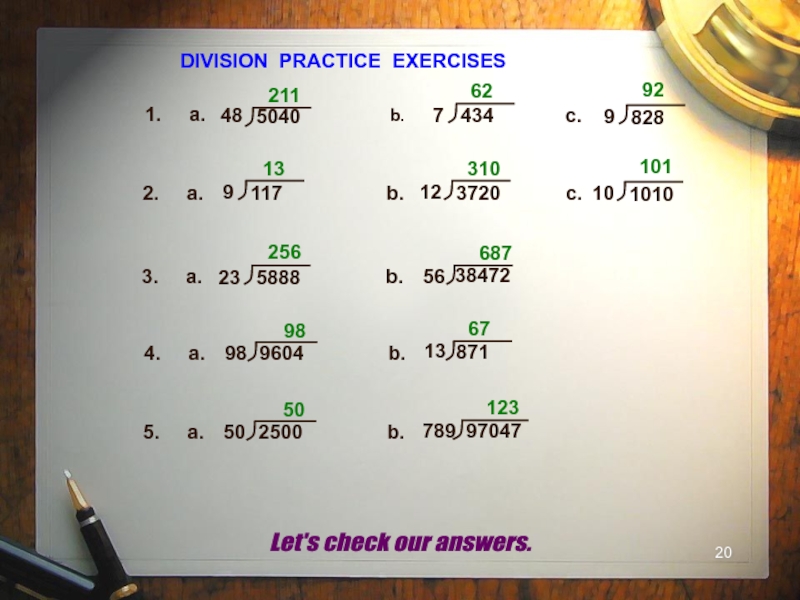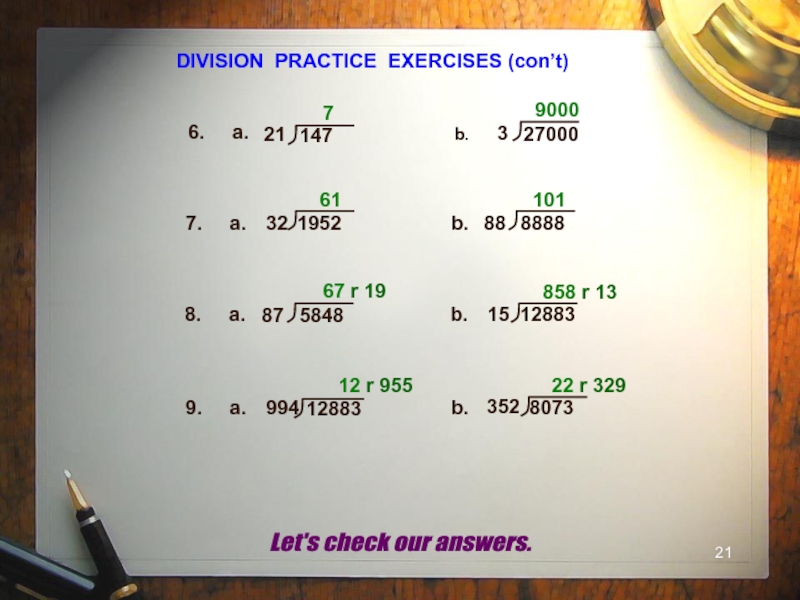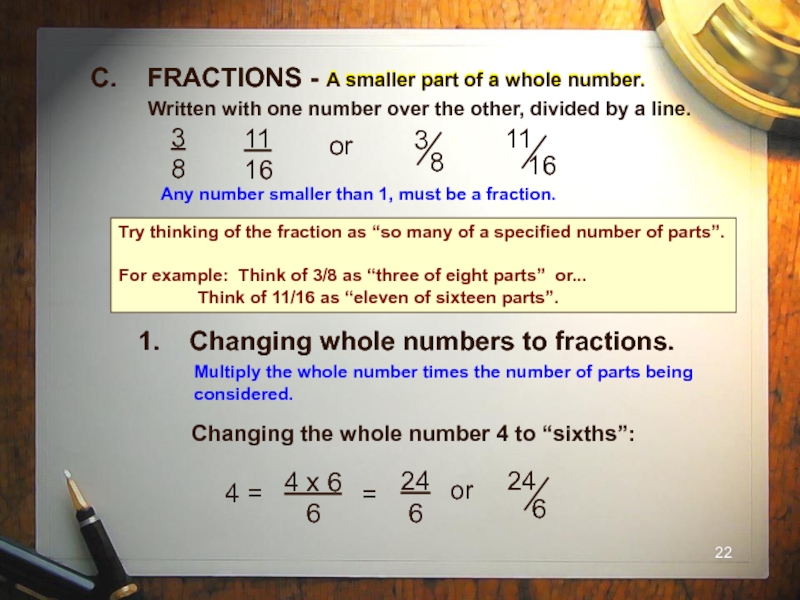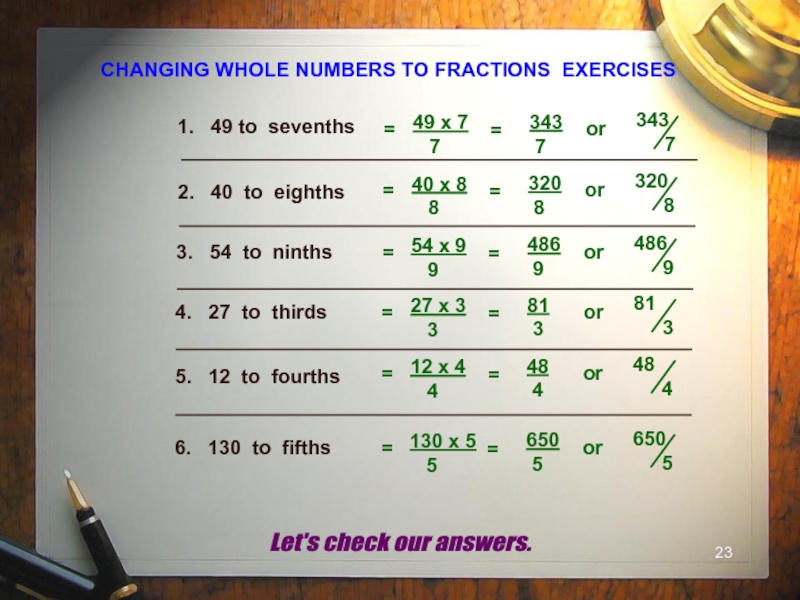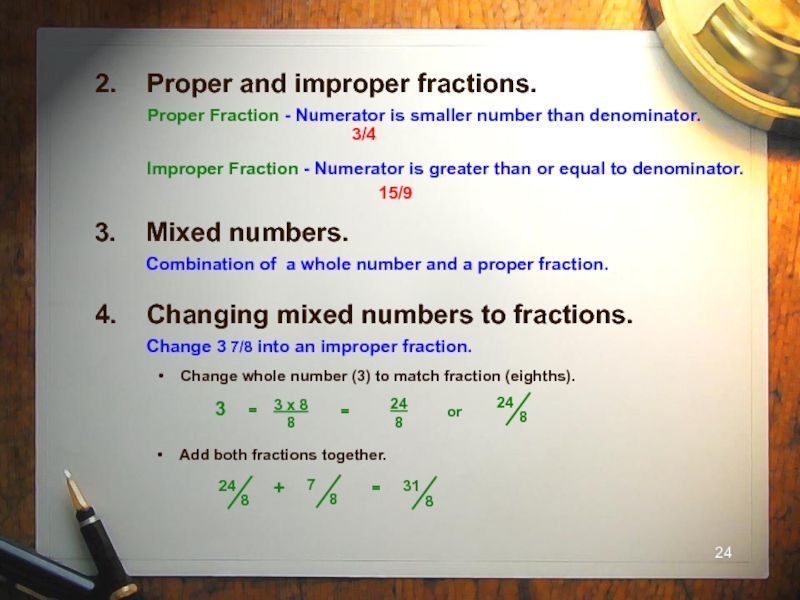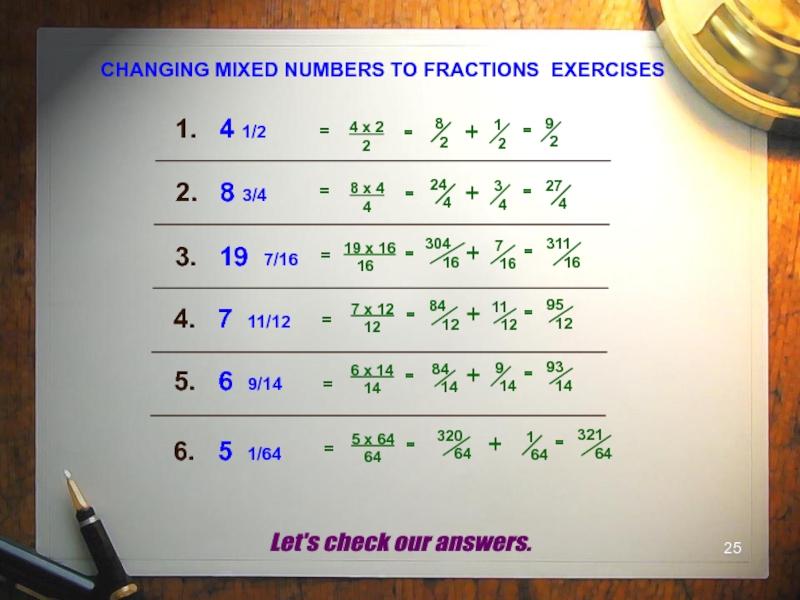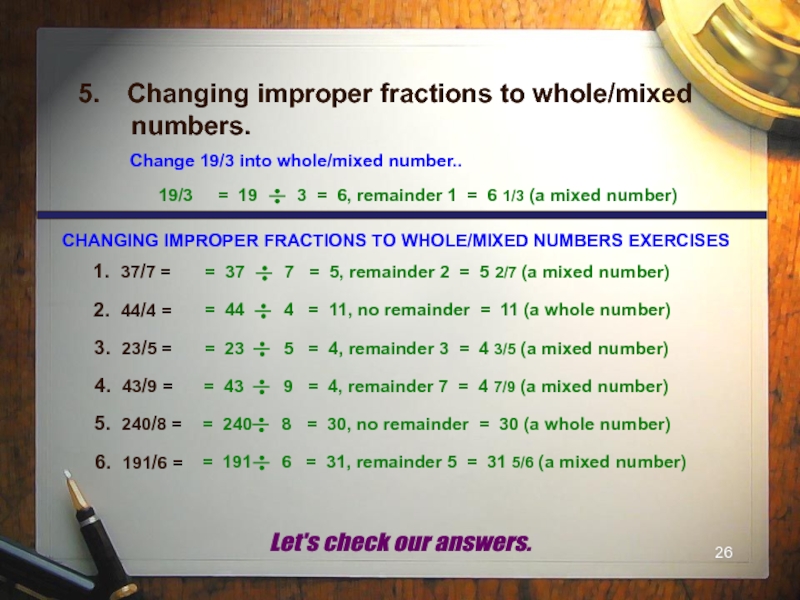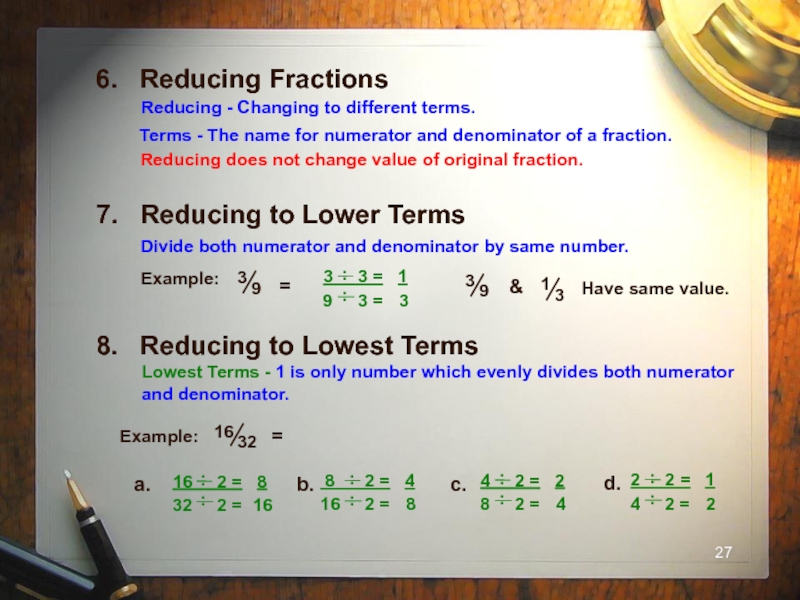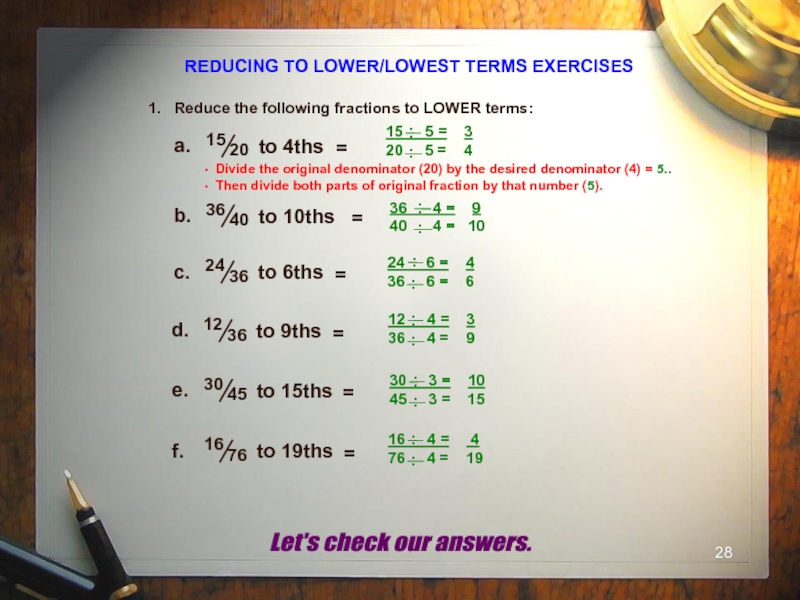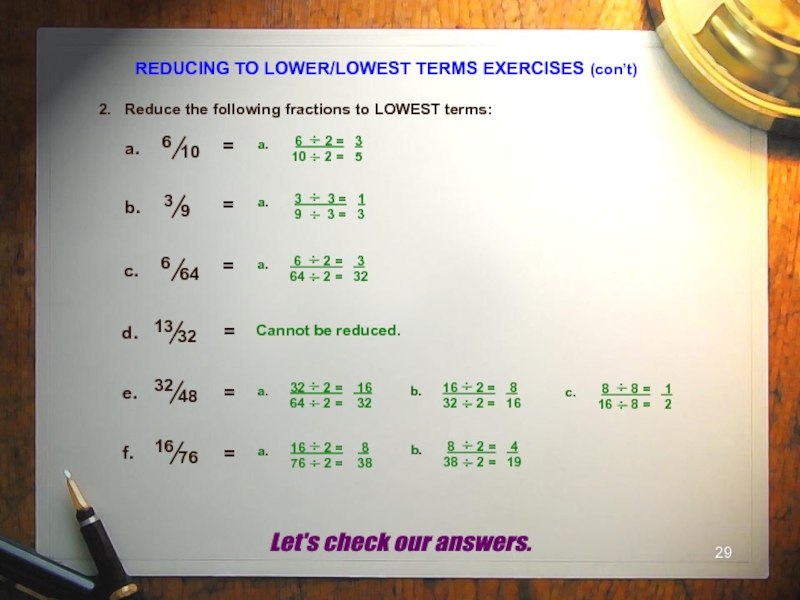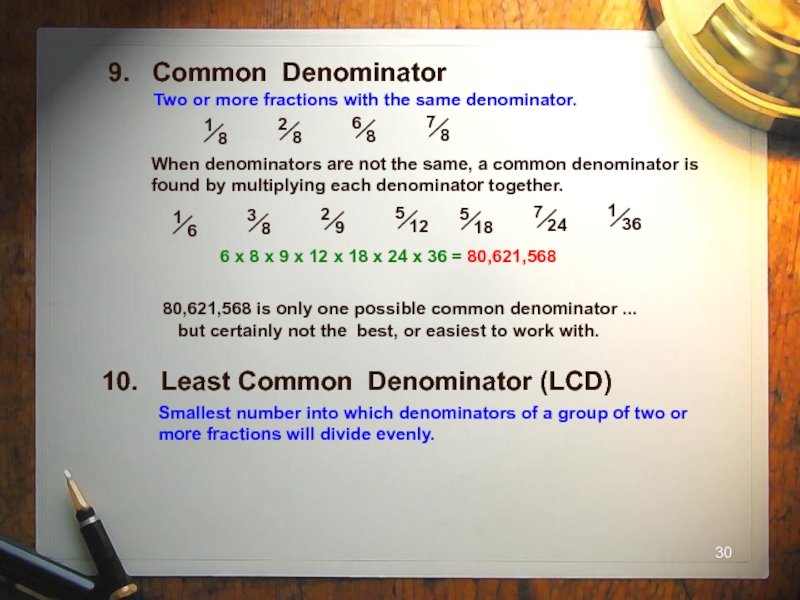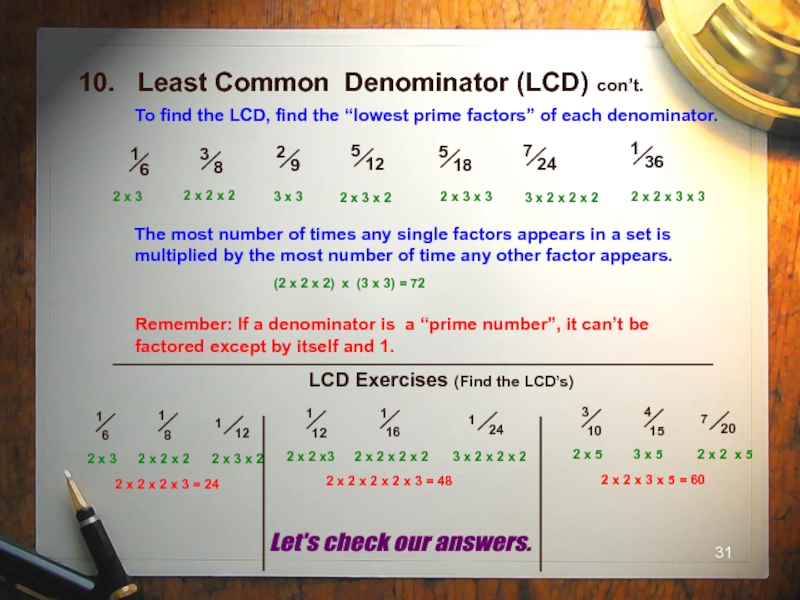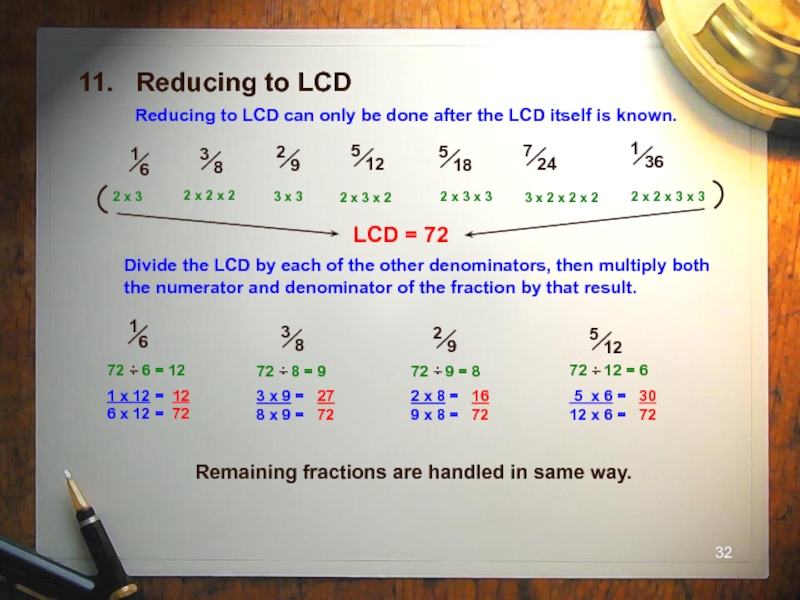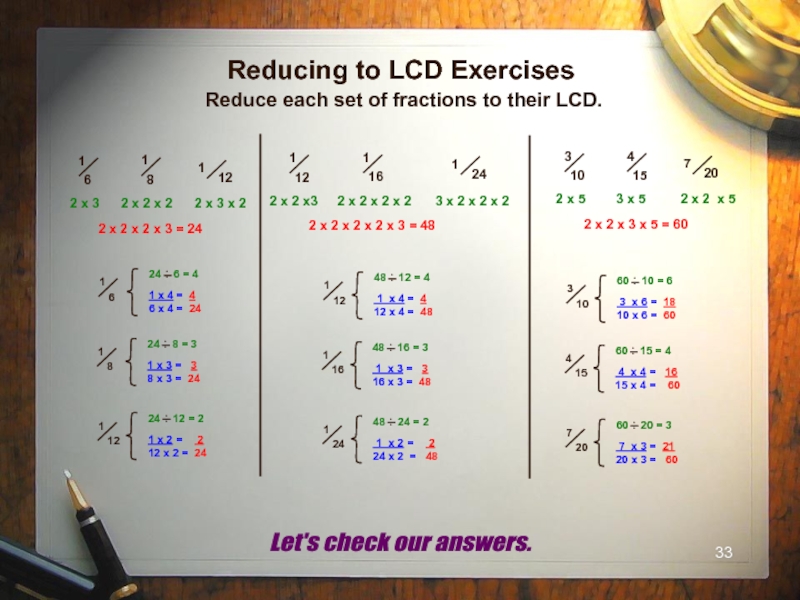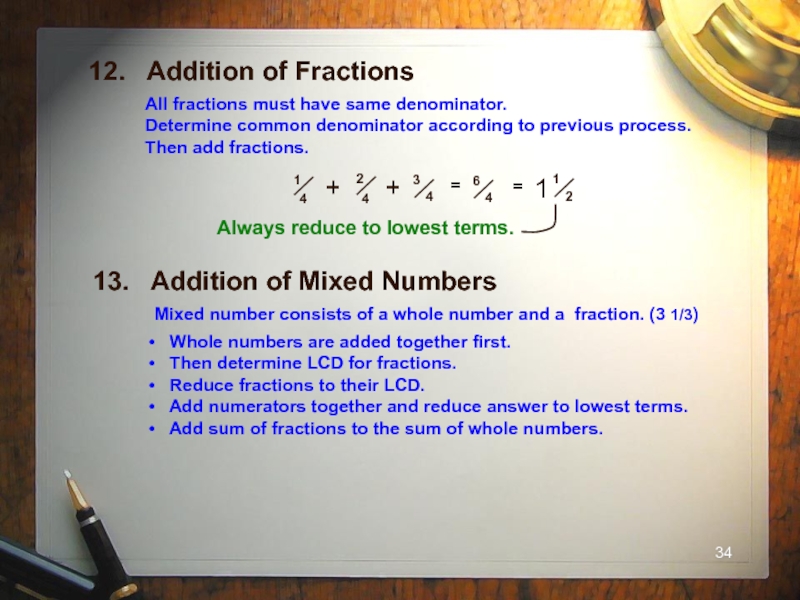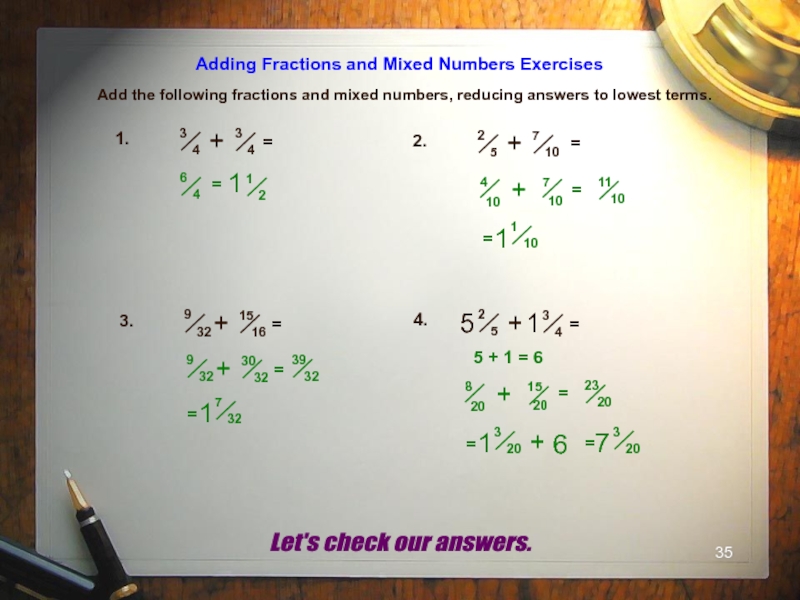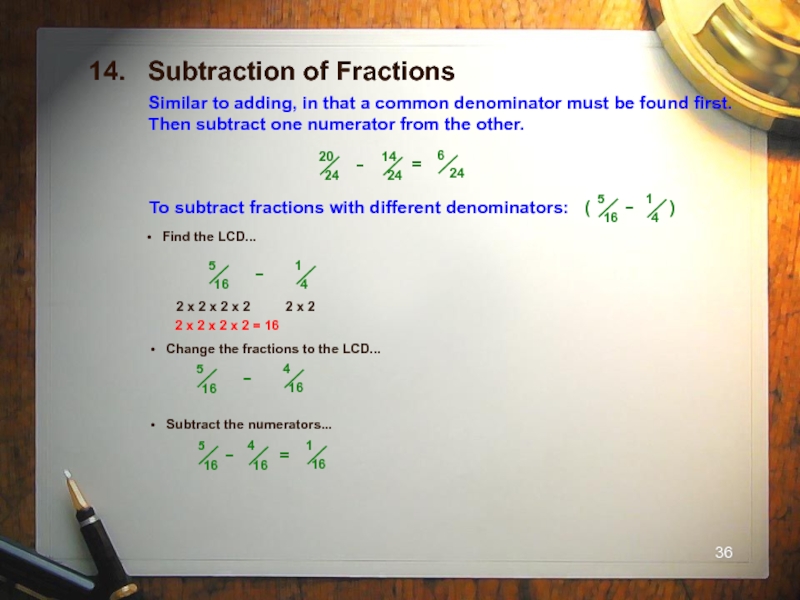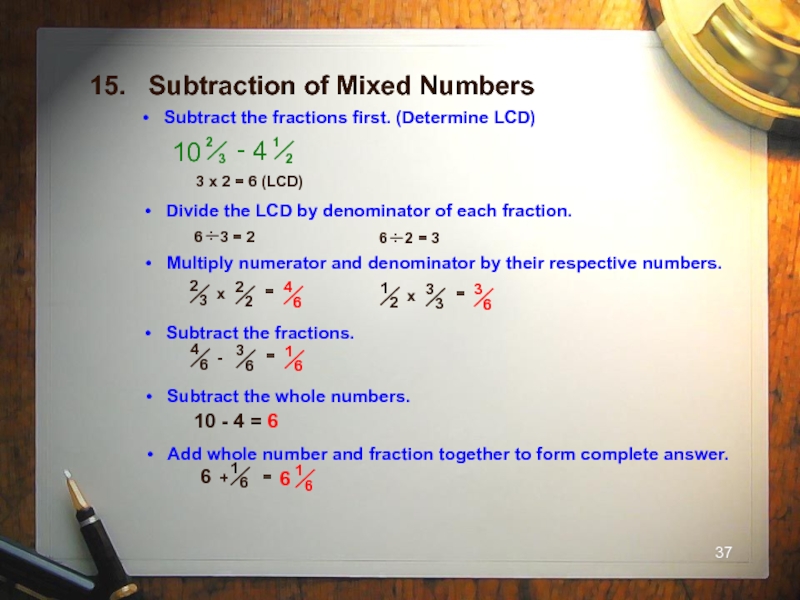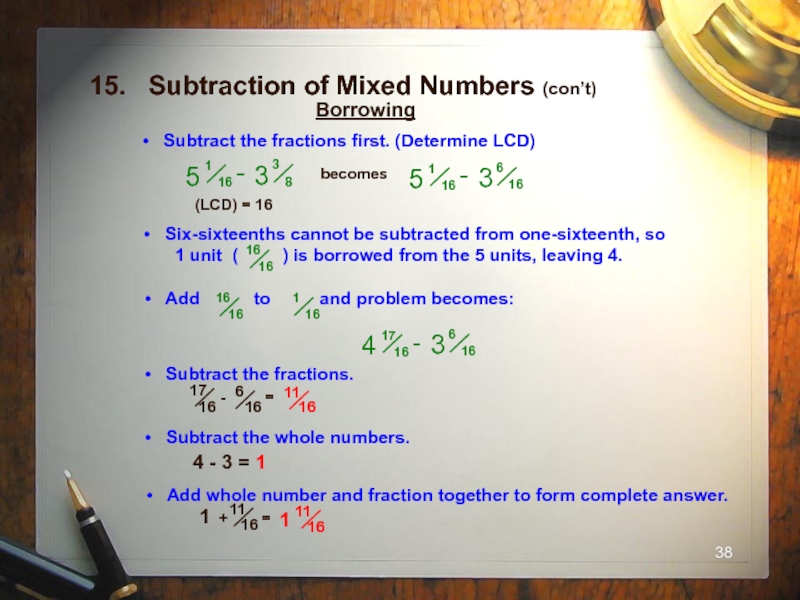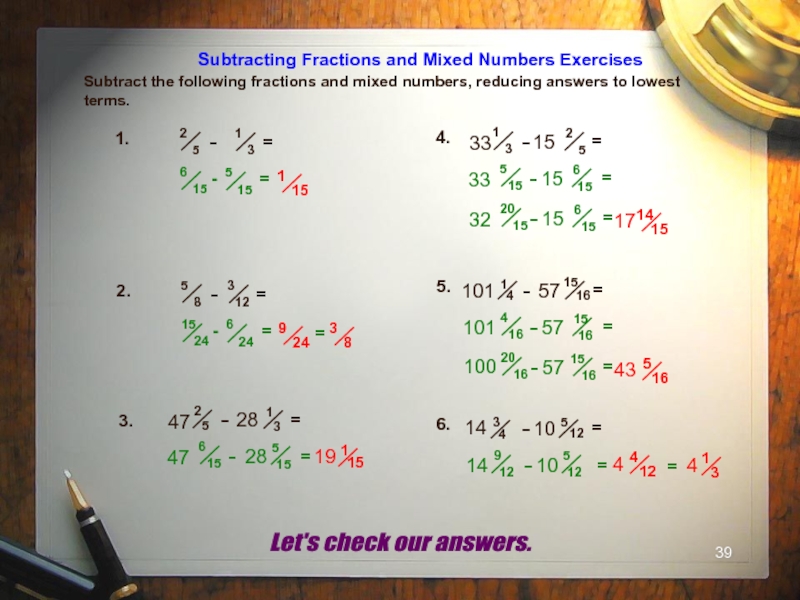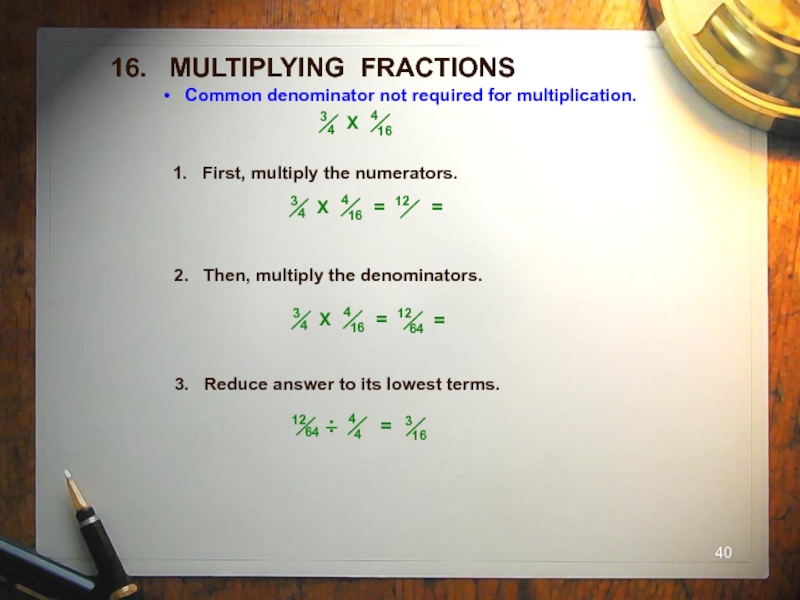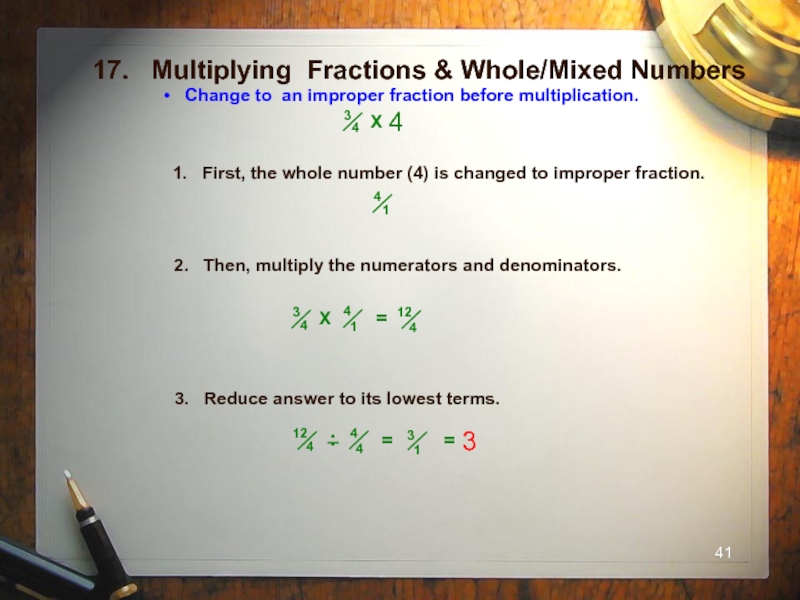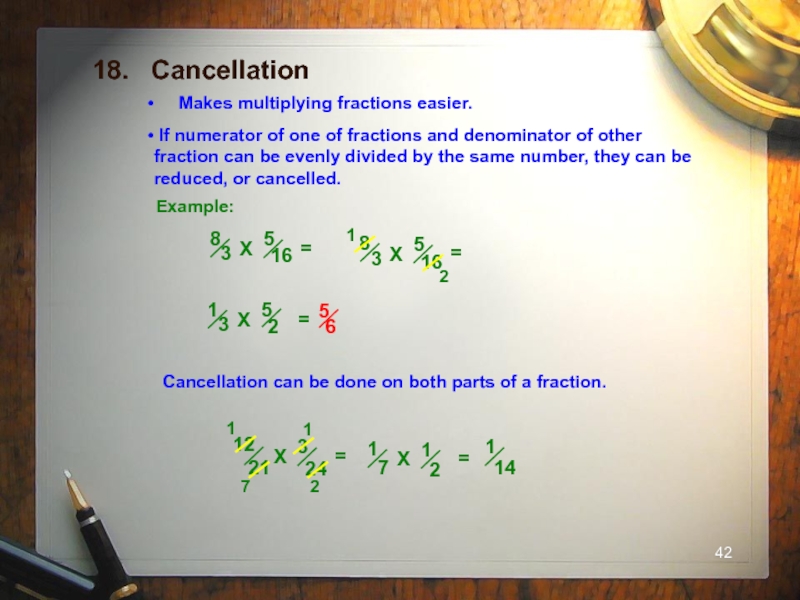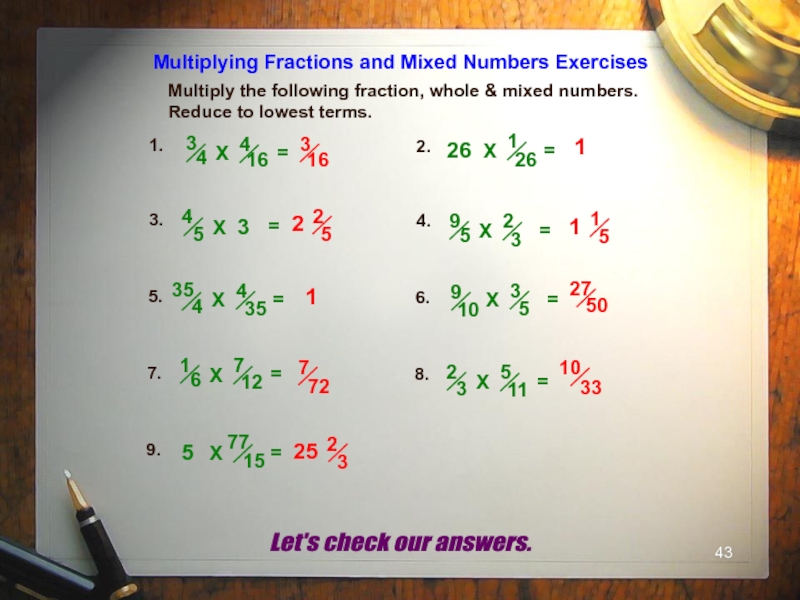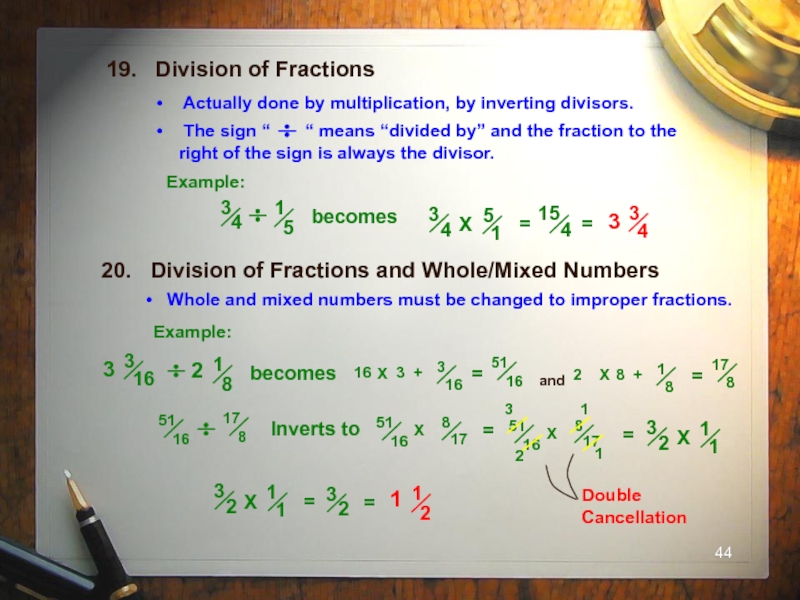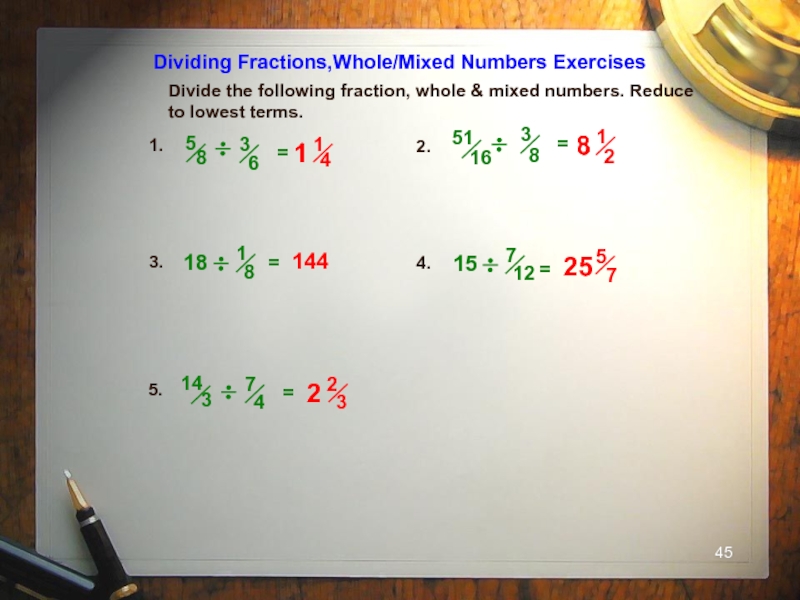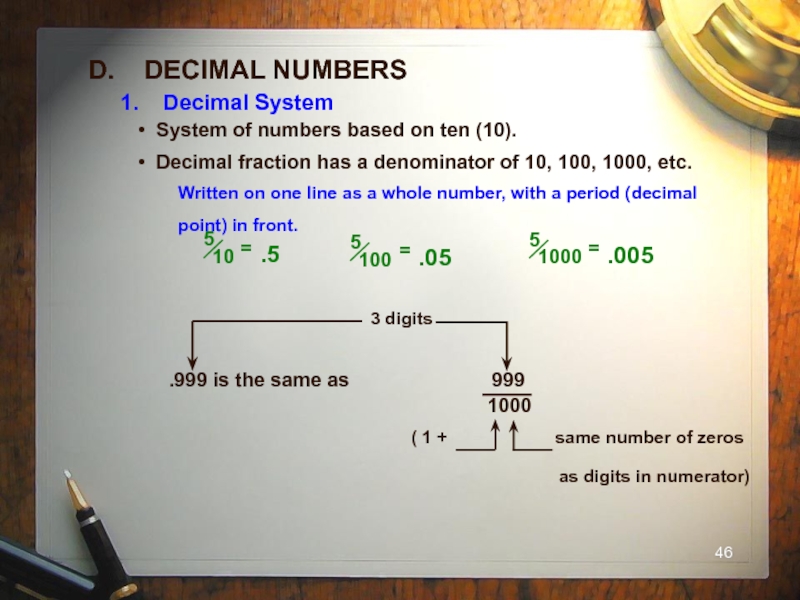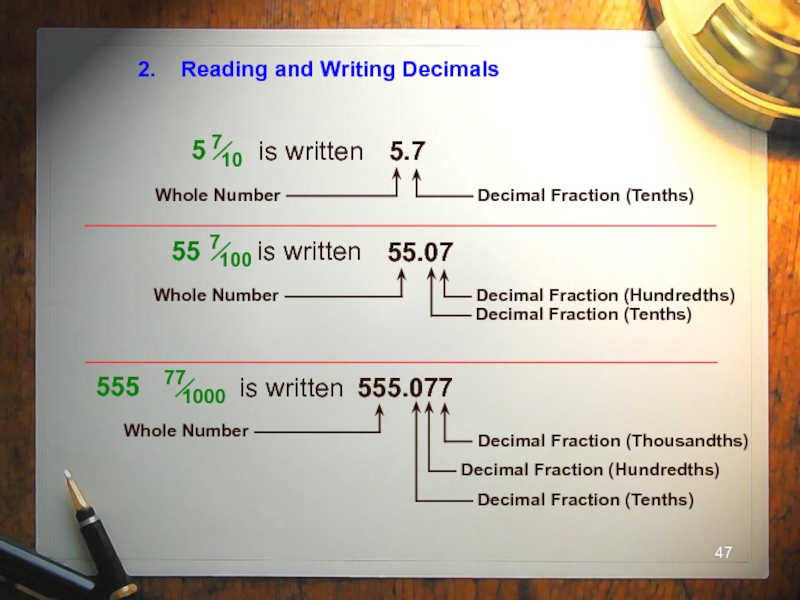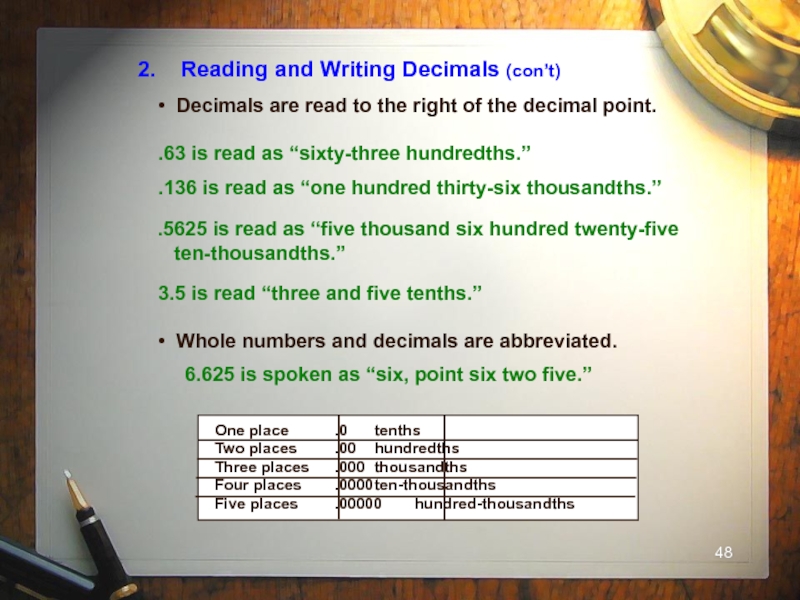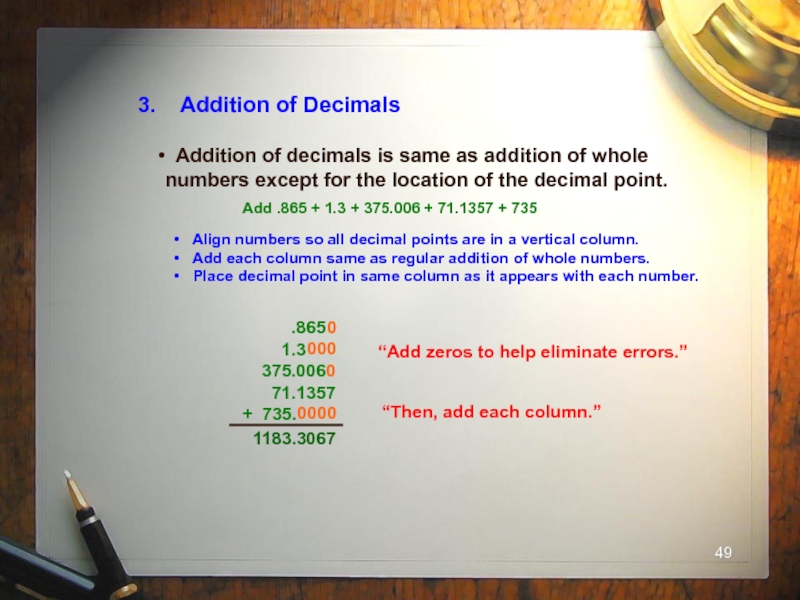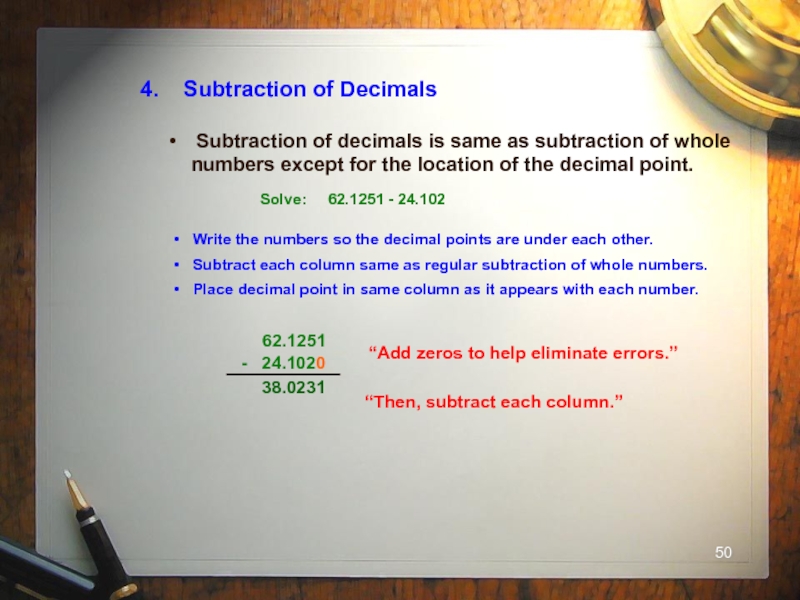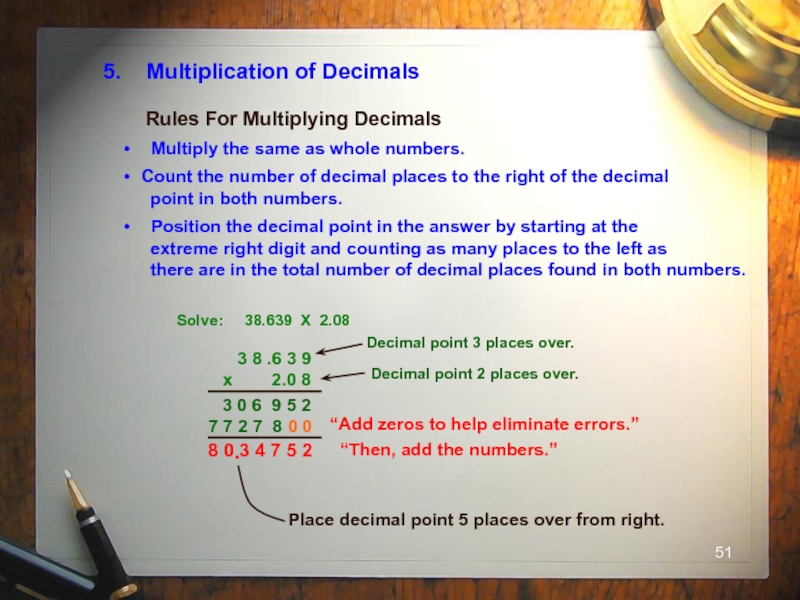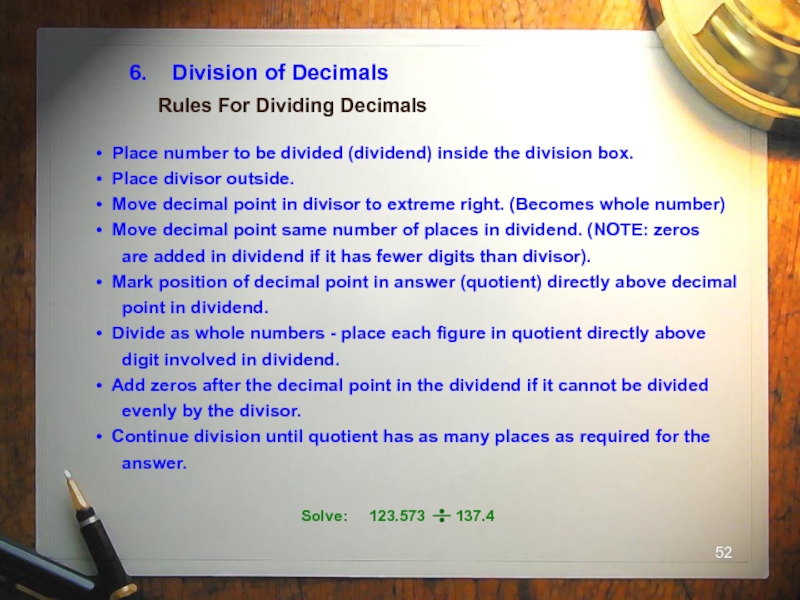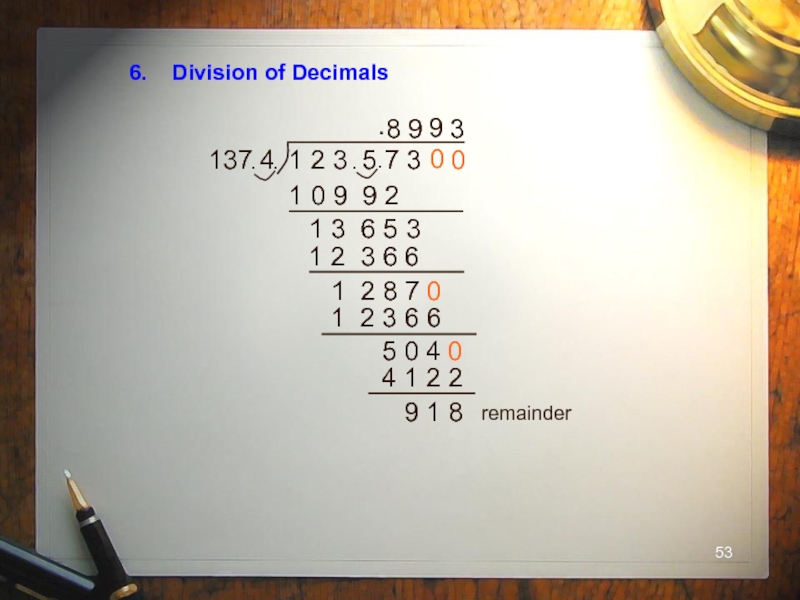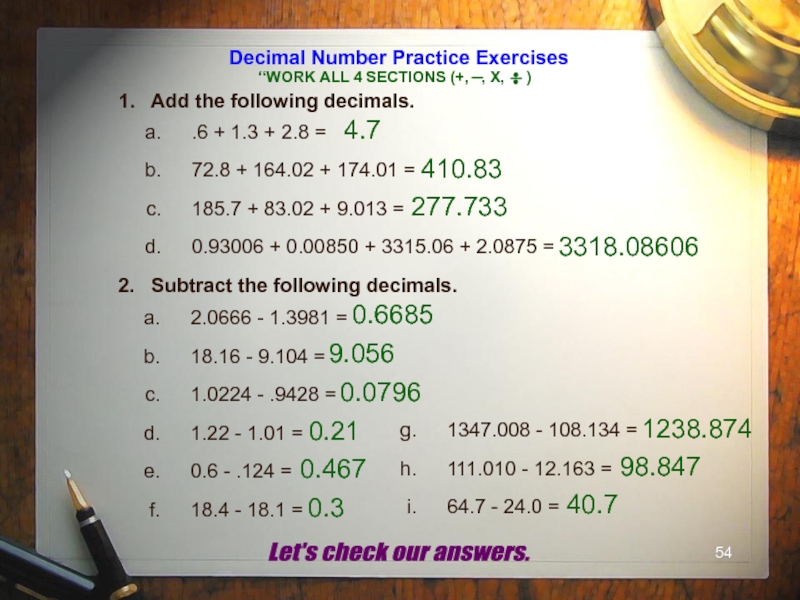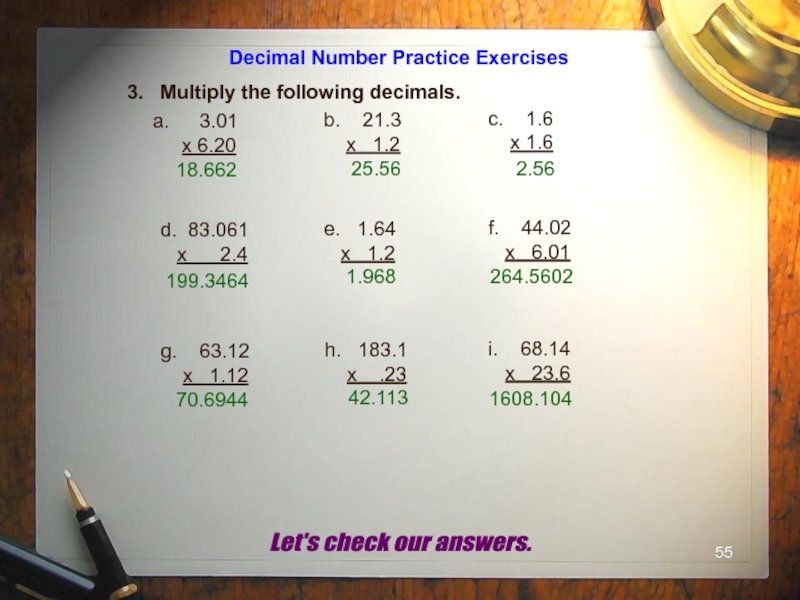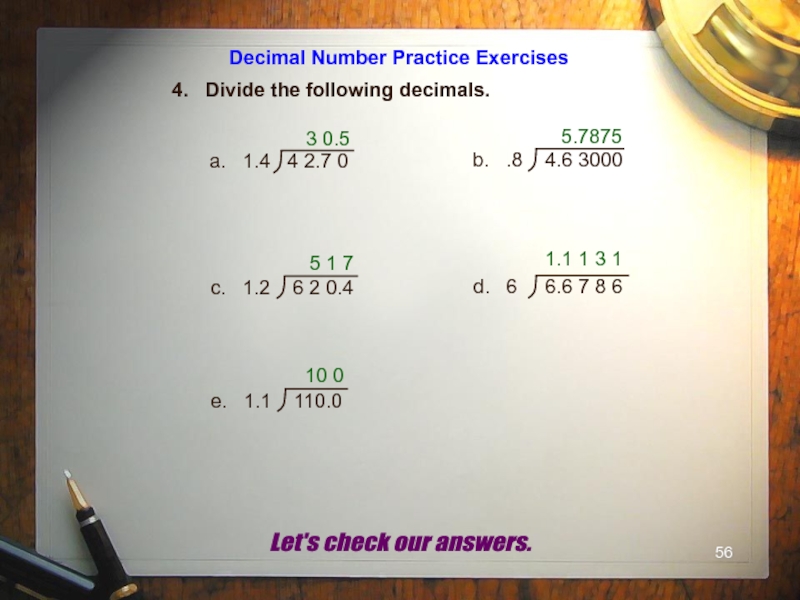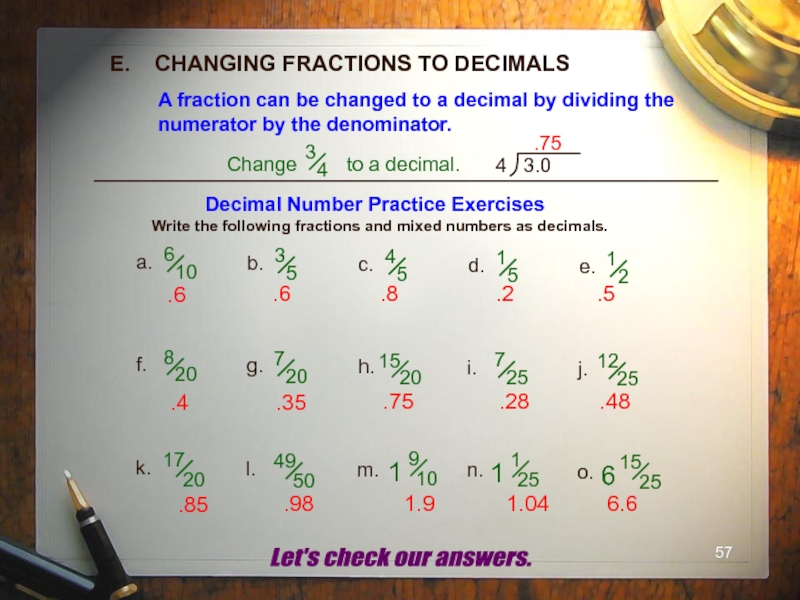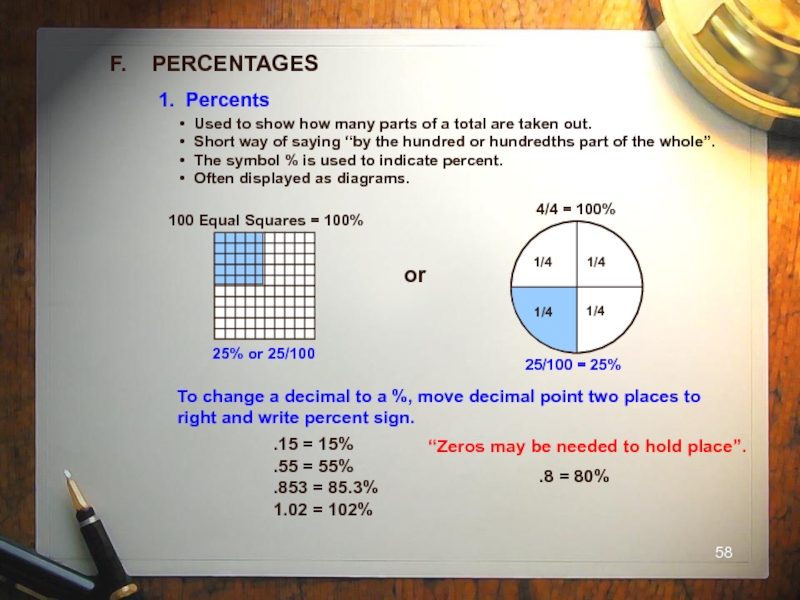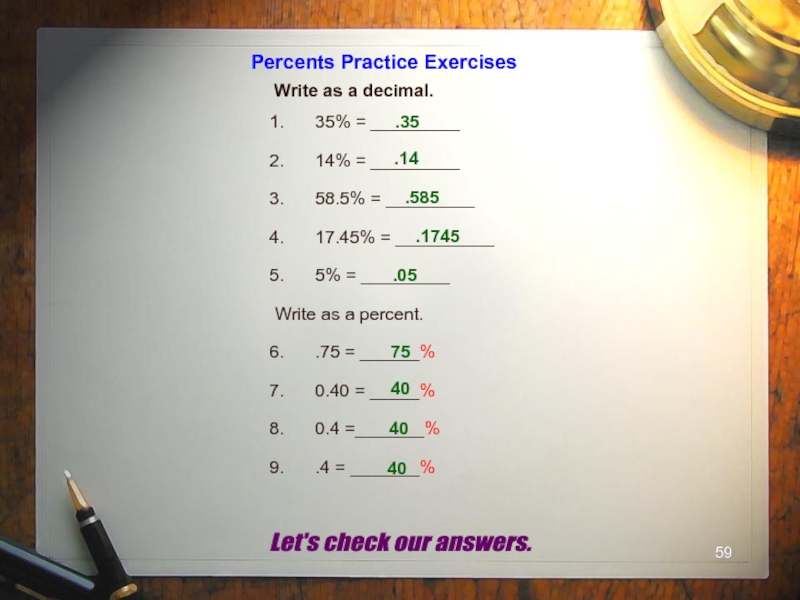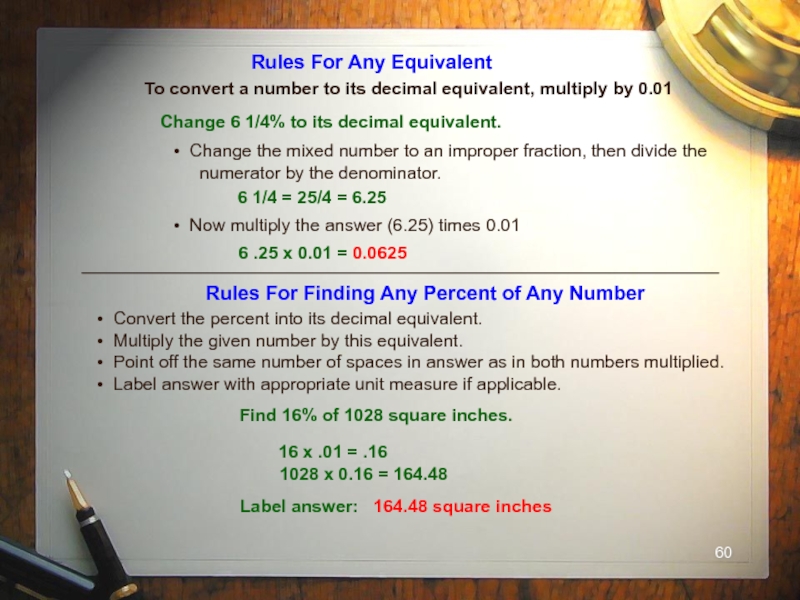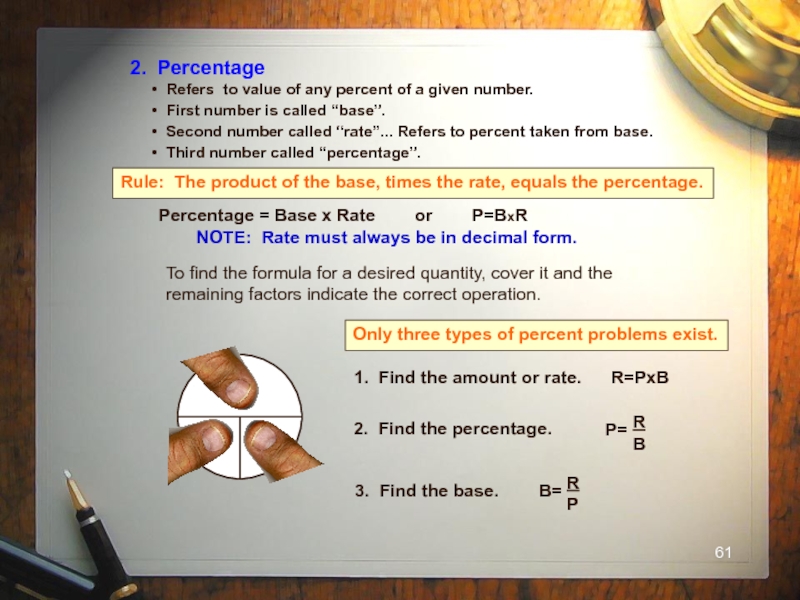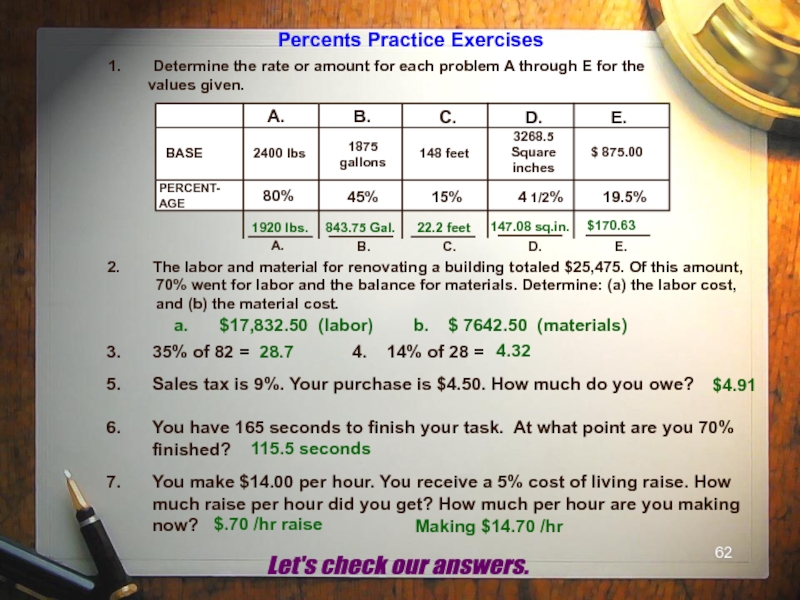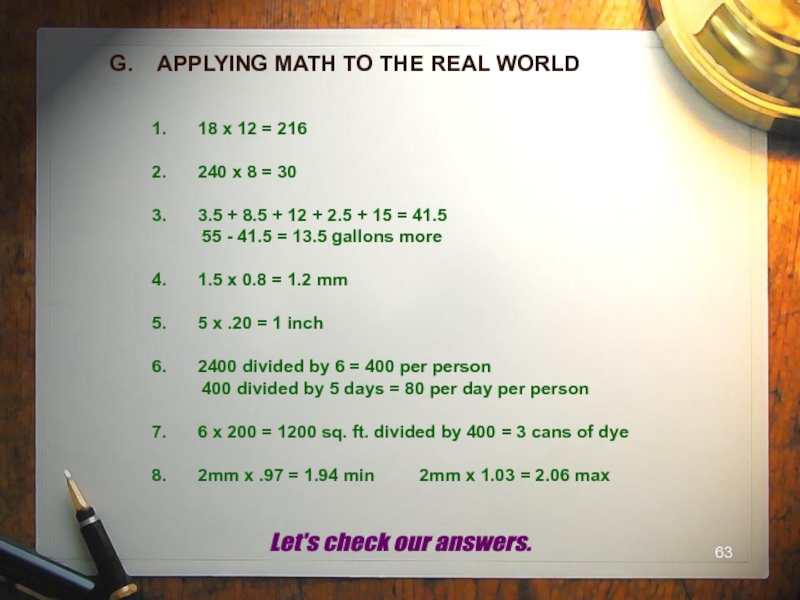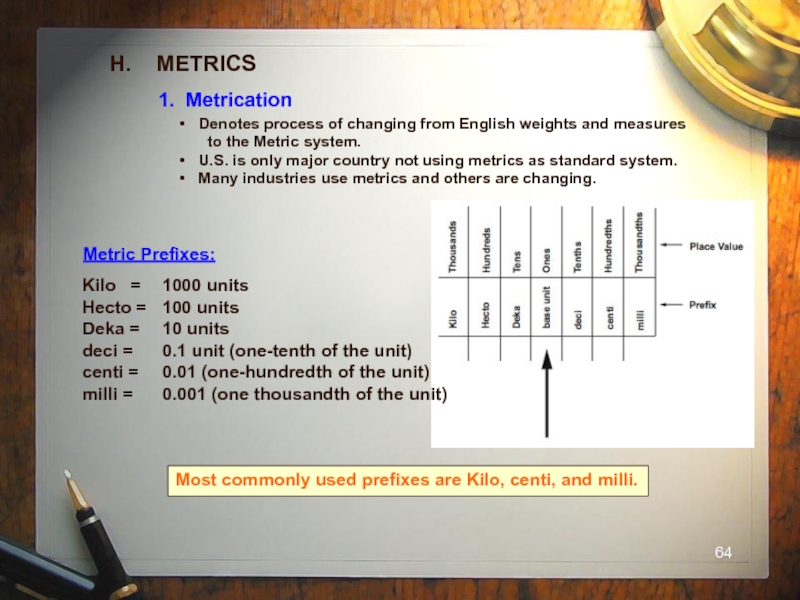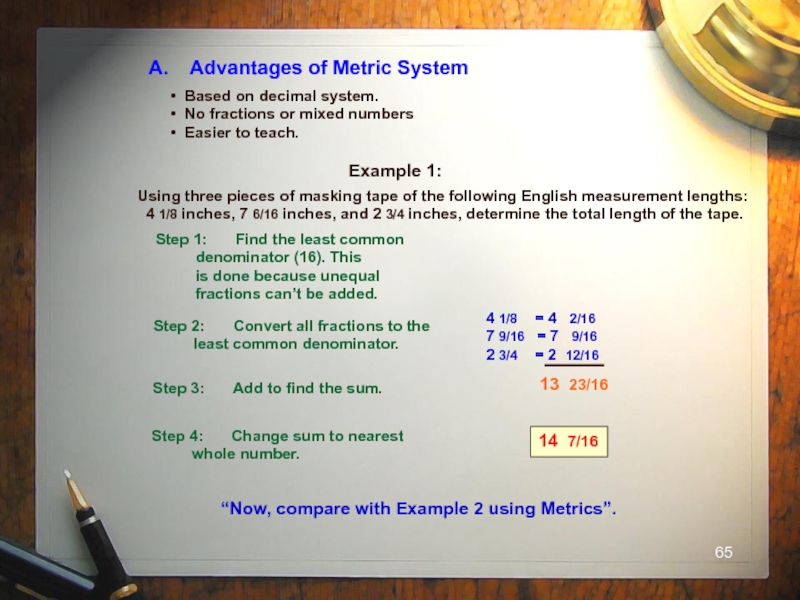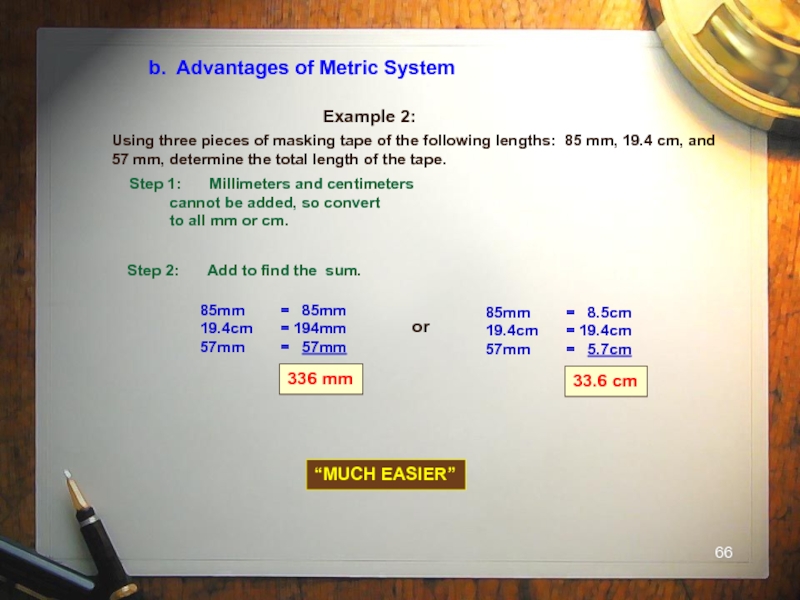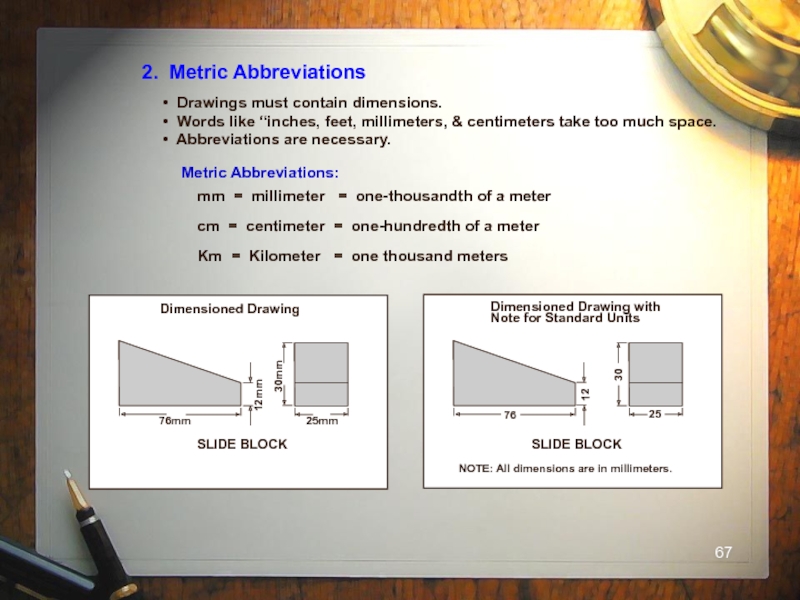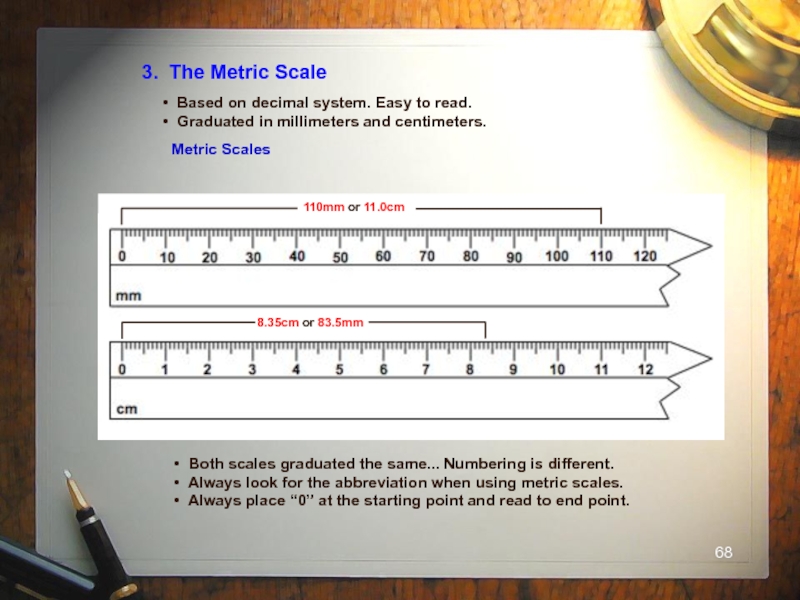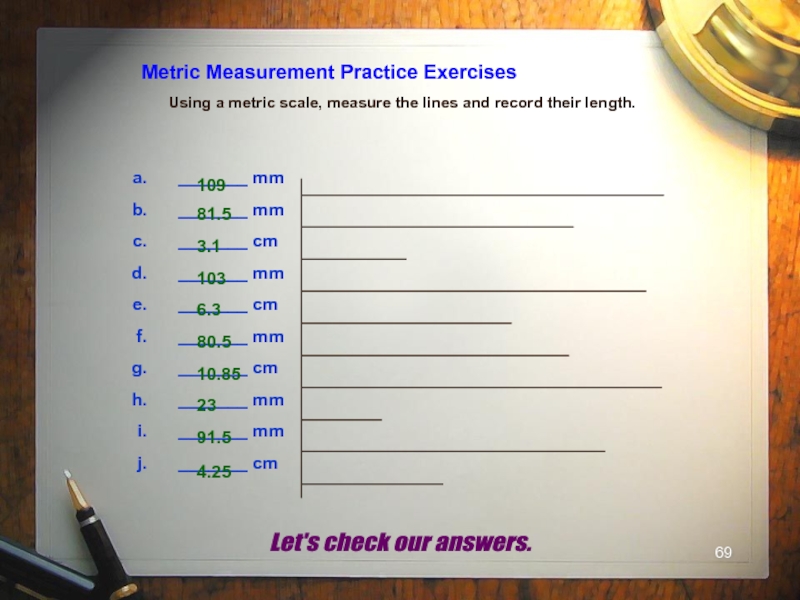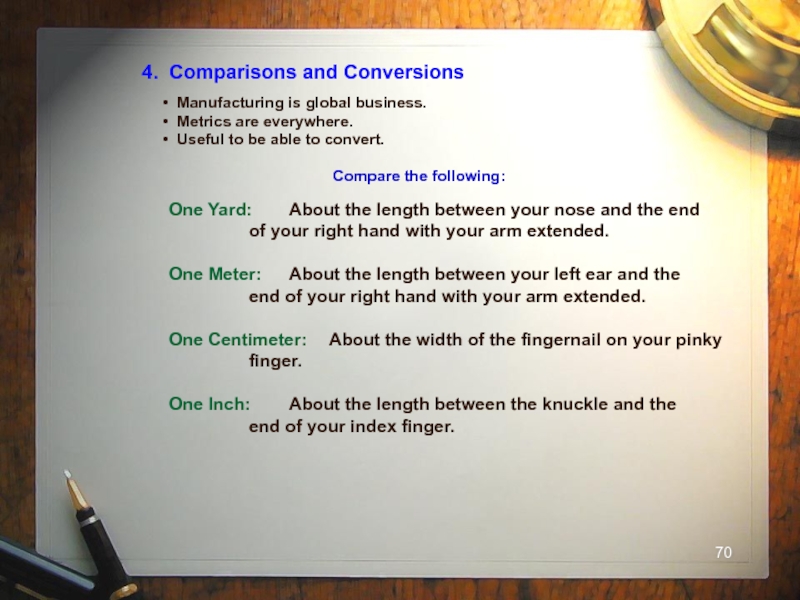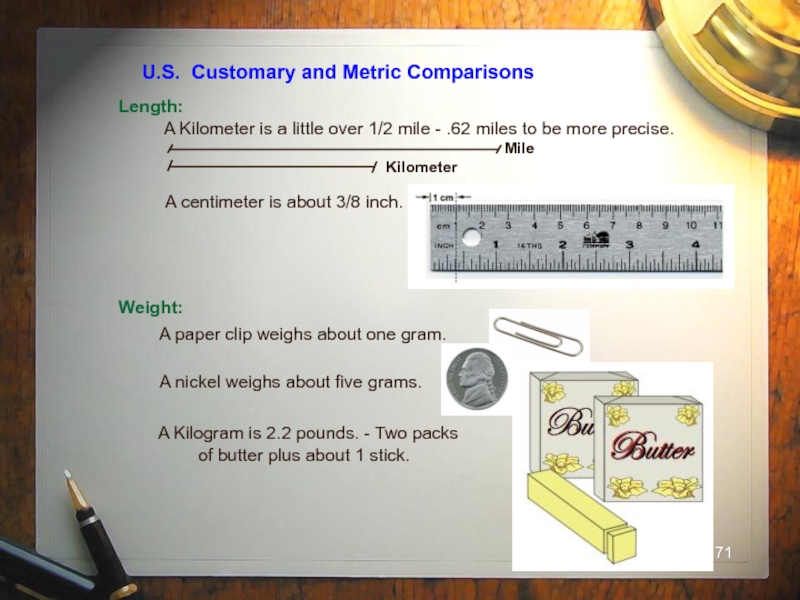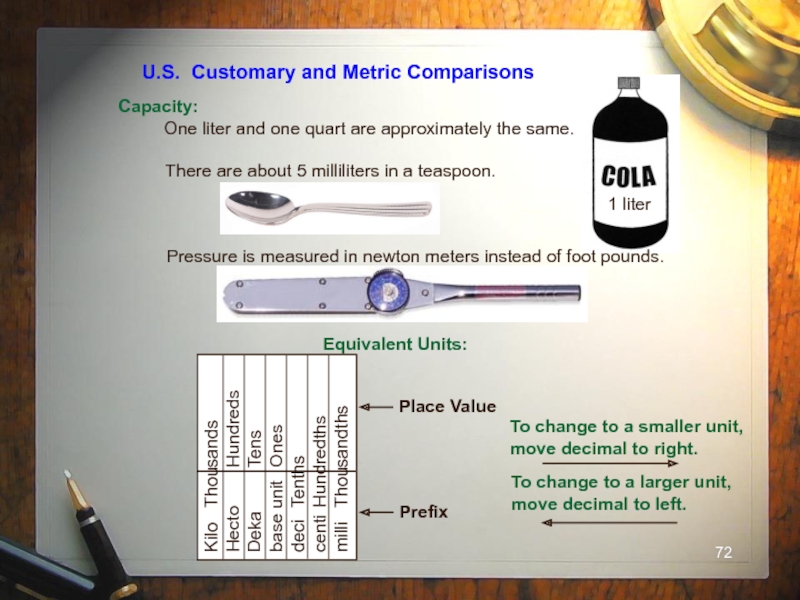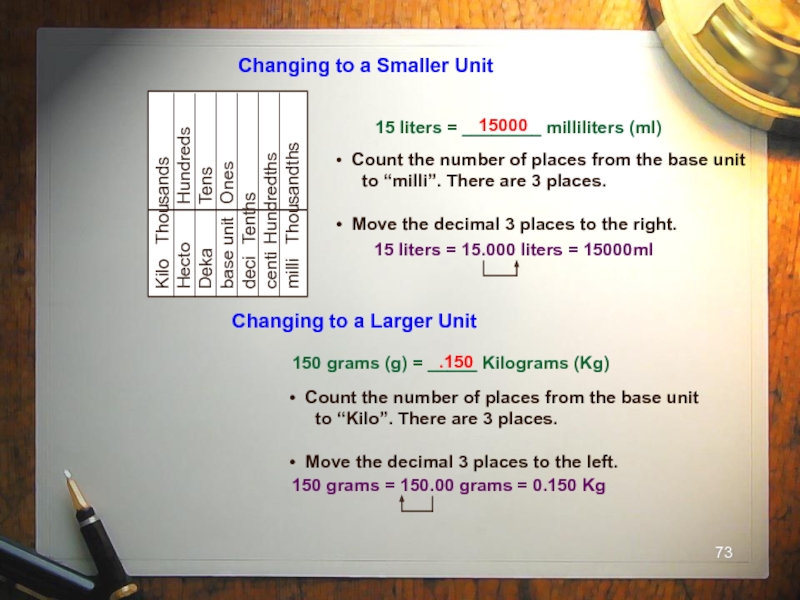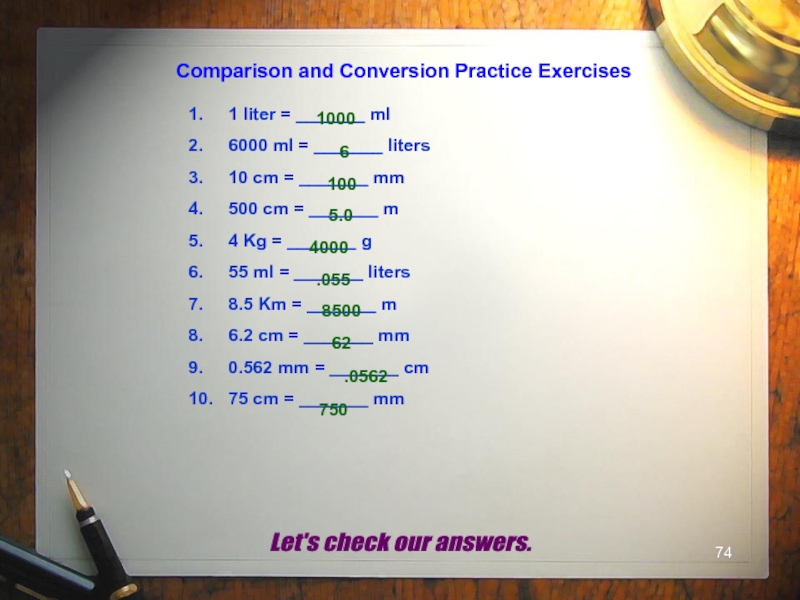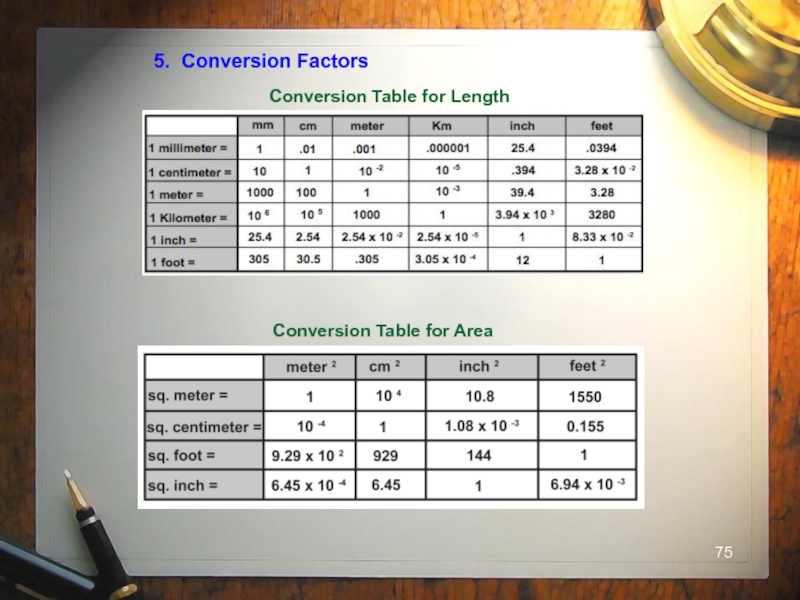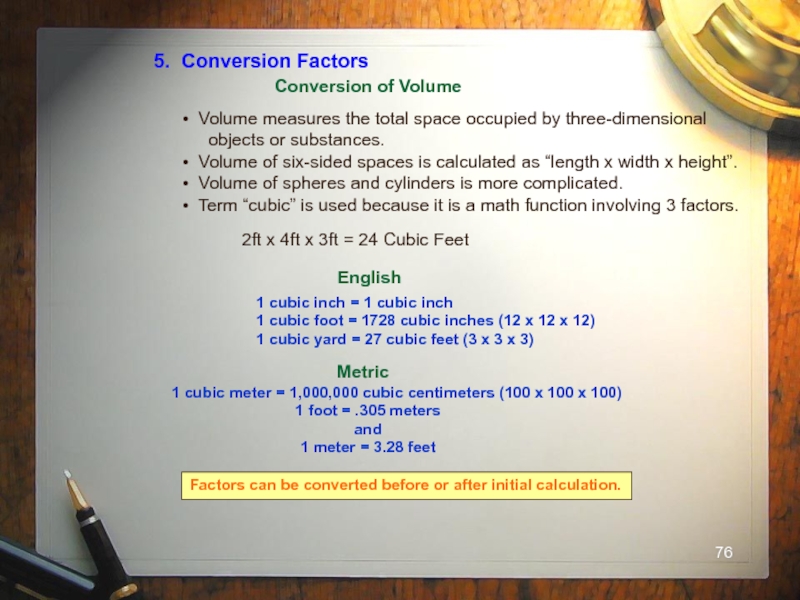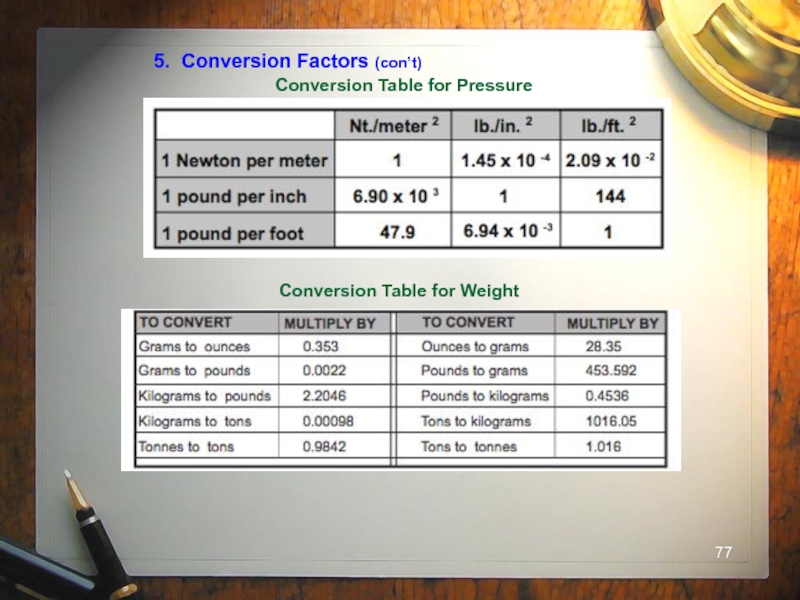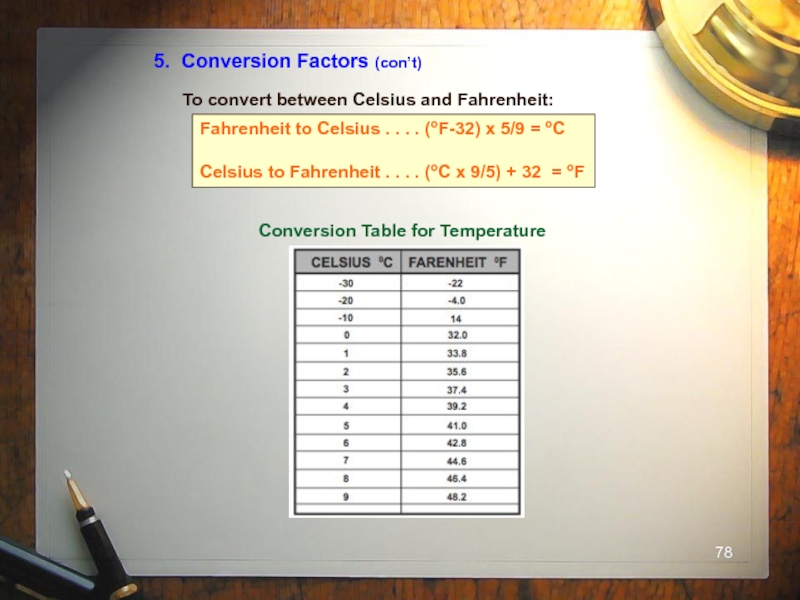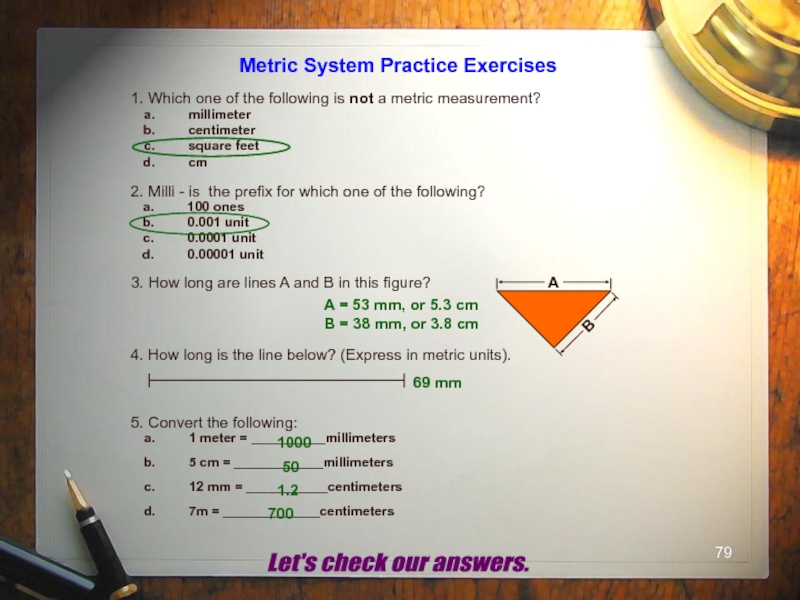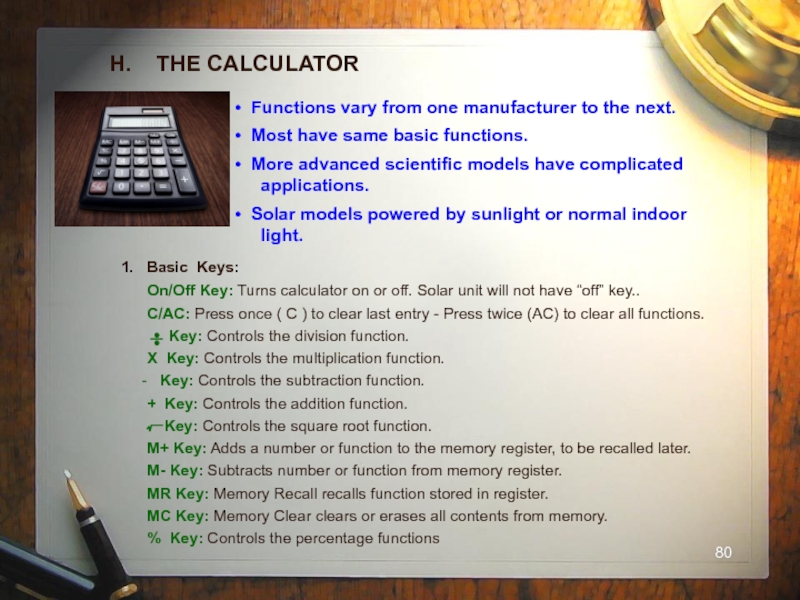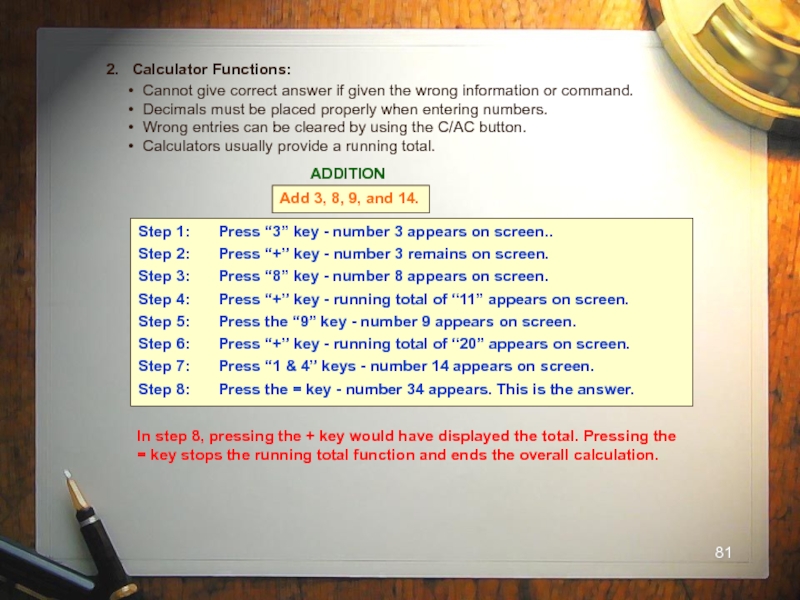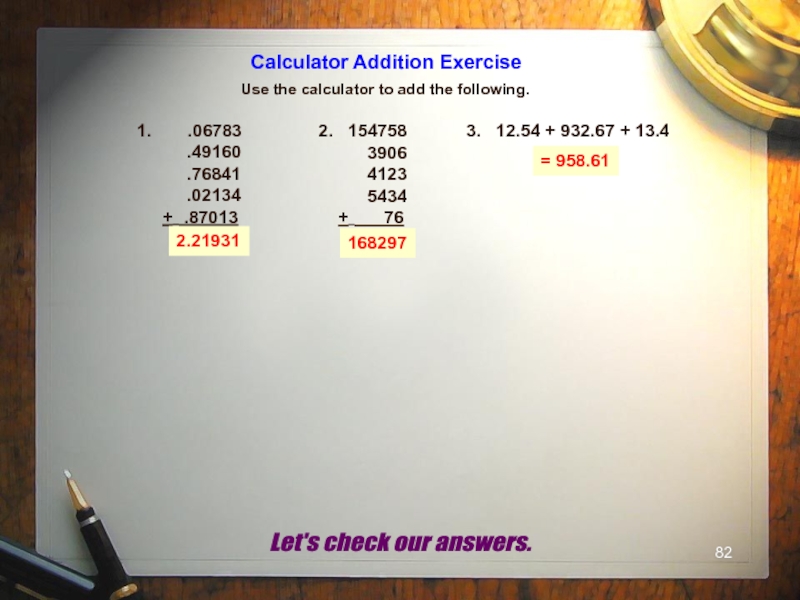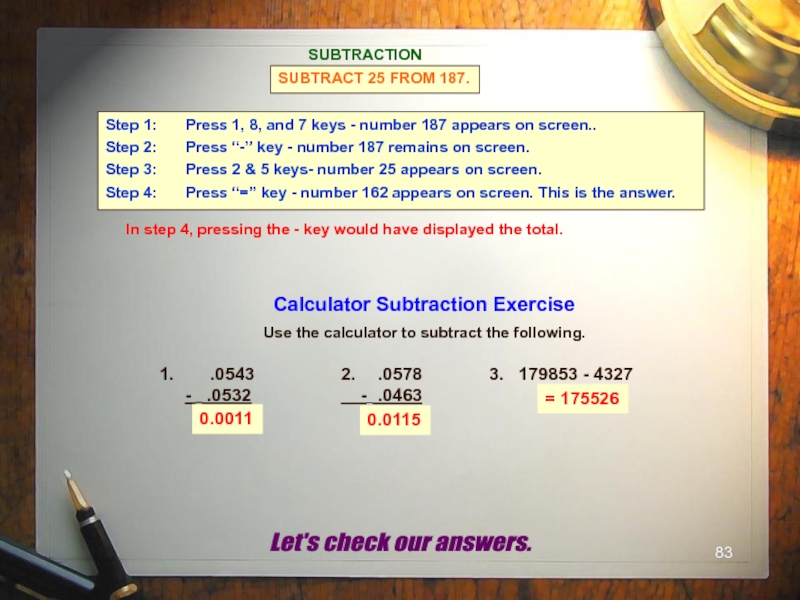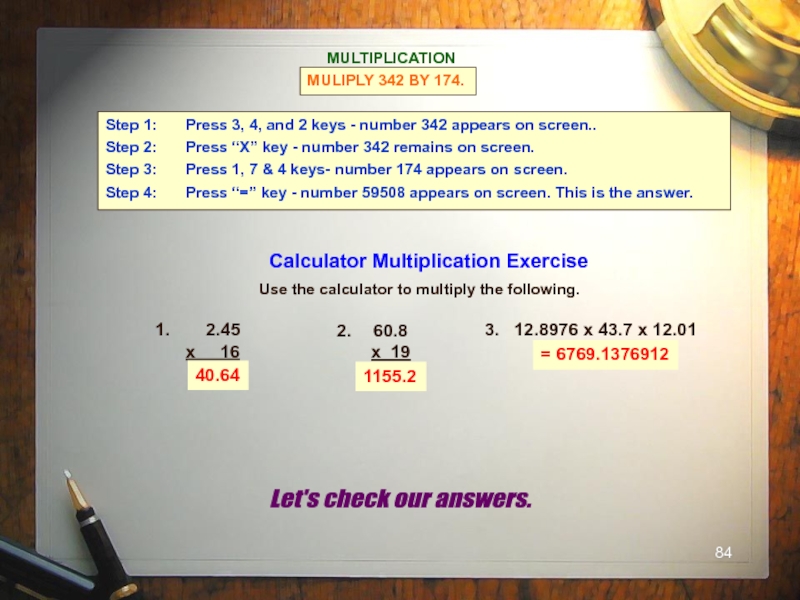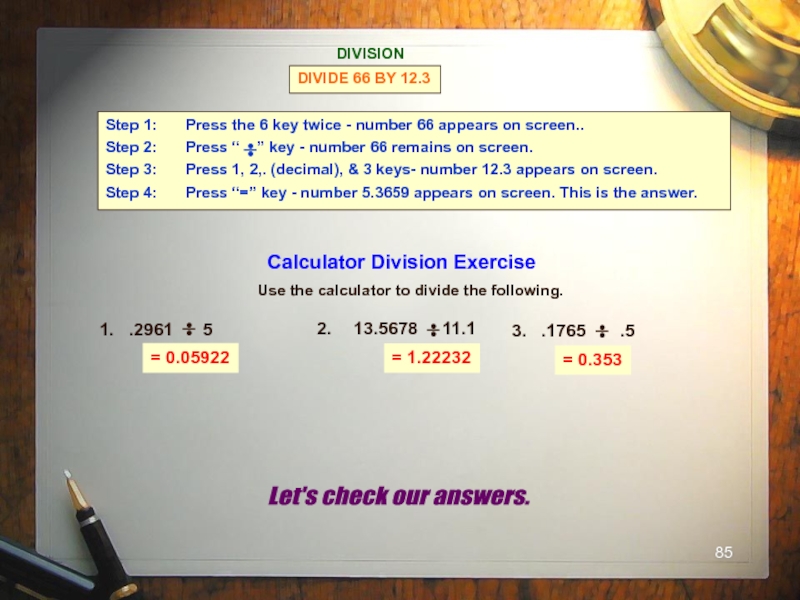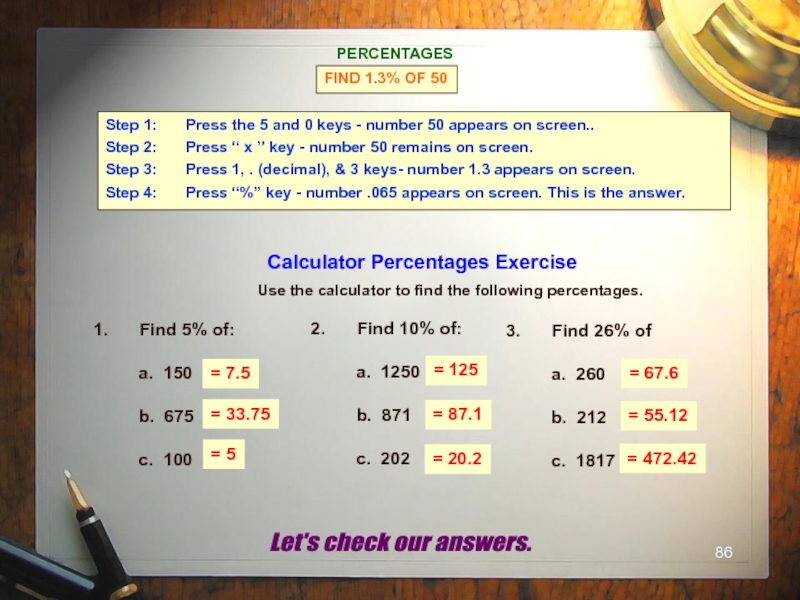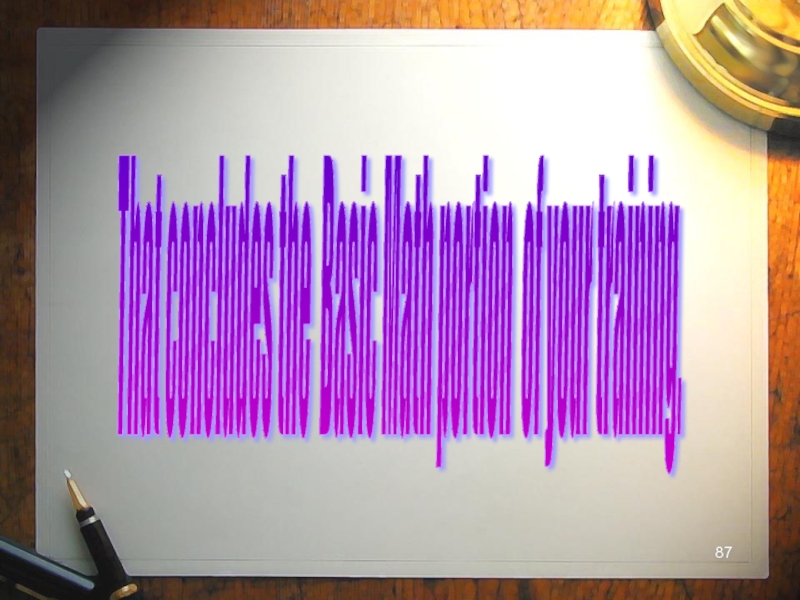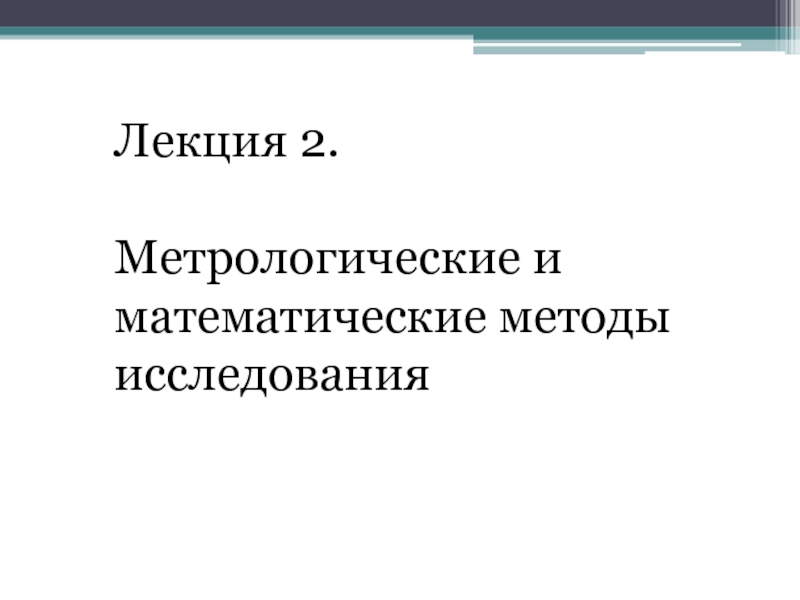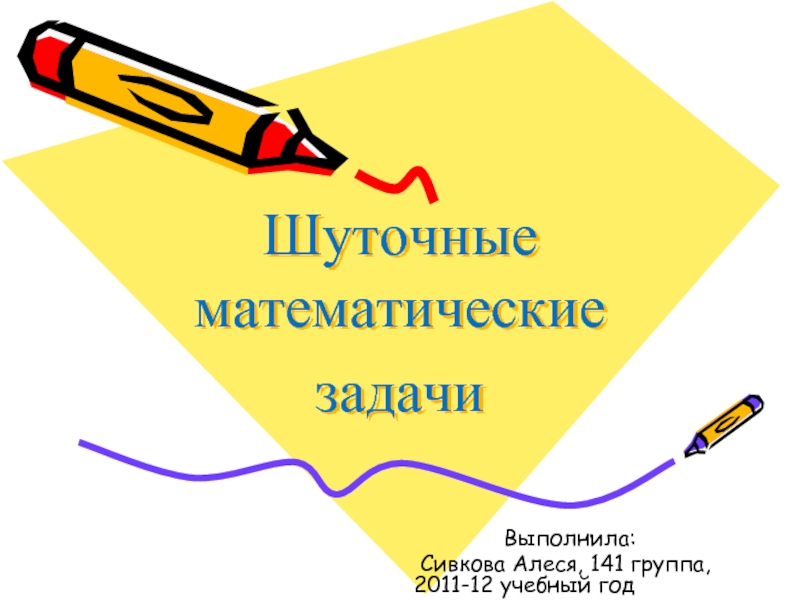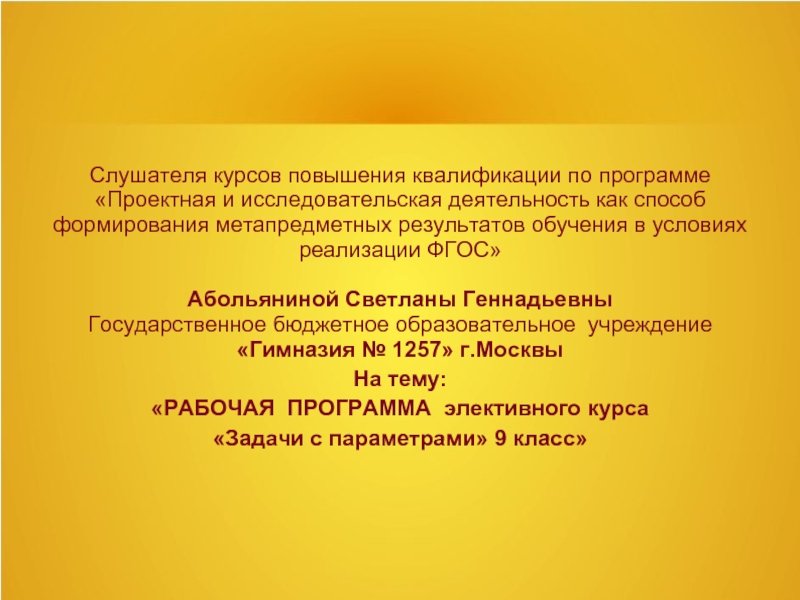- Главная
- Разное
- Дизайн
- Бизнес и предпринимательство
- Аналитика
- Образование
- Развлечения
- Красота и здоровье
- Финансы
- Государство
- Путешествия
- Спорт
- Недвижимость
- Армия
- Графика
- Культурология
- Еда и кулинария
- Лингвистика
- Английский язык
- Астрономия
- Алгебра
- Биология
- География
- Детские презентации
- Информатика
- История
- Литература
- Маркетинг
- Математика
- Медицина
- Менеджмент
- Музыка
- МХК
- Немецкий язык
- ОБЖ
- Обществознание
- Окружающий мир
- Педагогика
- Русский язык
- Технология
- Физика
- Философия
- Химия
- Шаблоны, картинки для презентаций
- Экология
- Экономика
- Юриспруденция
Basic arithmetic презентация
Содержание
- 1. Basic arithmetic
- 2. BASIC MATH A. BASIC ARITHMETIC
- 3. 1. Beginning Terminology Arabic number
- 4. 2. Kinds of numbers (con’t)
- 5. Number Line - Shows numerals
- 6. 1. Addition (con’t) Adding
- 7. ADDITION PRACTICE EXERCISES a. 222
- 8. 2. Subtraction Number Line
- 9. SUBTRACTION PRACTICE EXERCISES a.
- 10. SUBTRACTION PRACTICE EXERCISES (con’t) 4.
- 11. 3. Checking Addition and Subtraction
- 12. CHECKING ADDITION & SUBTRACTION PRACTICE EXERCISES
- 13. CHECKING ADDITION & SUBTRACTION PRACTICE EXERCISES
- 14. 4. Multiplication
- 15. Complex Multiplication - Carry result
- 16. MULTIPLICATION PRACTICE EXERCISES a.
- 17. MULTIPLICATION PRACTICE EXERCISES (con’t) 4.
- 18. Finding out how many times
- 19. 5. Division (con’t) 1 48
- 20. DIVISION PRACTICE EXERCISES 1.
- 21. DIVISION PRACTICE EXERCISES (con’t) 6.
- 22. 1. Changing whole numbers to fractions.
- 23. CHANGING WHOLE NUMBERS TO FRACTIONS EXERCISES
- 25. CHANGING MIXED NUMBERS TO FRACTIONS EXERCISES 1.
- 26. Changing improper fractions to whole/mixed
- 28. REDUCING TO LOWER/LOWEST TERMS EXERCISES 1.
- 29. REDUCING TO LOWER/LOWEST TERMS EXERCISES (con’t) 2.
- 30. 9. Common Denominator Two or more
- 31. The most number of times any single
- 32. Divide the LCD by each of the
- 33. Reducing to LCD Exercises Reduce each set
- 34. Whole numbers are added together
- 35. Adding Fractions and Mixed Numbers Exercises Add
- 36. 14. Subtraction of Fractions Similar to
- 37. 15. Subtraction of Mixed Numbers
- 38. 15. Subtraction of Mixed Numbers (con’t) Borrowing
- 39. Subtracting Fractions and Mixed Numbers Exercises Subtract
- 40. 16. MULTIPLYING FRACTIONS Common
- 41. 17. Multiplying Fractions & Whole/Mixed Numbers
- 42. 18. Cancellation Makes
- 43. Multiply the following fraction, whole & mixed
- 45. Divide the following fraction, whole & mixed
- 46. D. DECIMAL NUMBERS System of
- 47. 2. Reading and Writing Decimals
- 48. 2. Reading and Writing Decimals (con’t)
- 49. 3. Addition of Decimals Addition
- 50. 4. Subtraction of Decimals Subtraction
- 51. 5. Multiplication of Decimals Multiply
- 52. 6. Division of Decimals Place
- 53. 6. Division of Decimals 137 4
- 54. Decimal Number Practice Exercises 1.
- 55. Decimal Number Practice Exercises 3.
- 56. Decimal Number Practice Exercises 4.
- 57. E. CHANGING FRACTIONS TO DECIMALS A
- 58. F. PERCENTAGES 1. Percents Used
- 59. Percents Practice Exercises Write as a decimal.
- 60. Rules For Any Equivalent To convert a
- 61. 2. Percentage Refers to value of
- 62. Percents Practice Exercises Determine the rate or
- 63. G. APPLYING MATH TO THE REAL
- 64. H. METRICS 1. Metrication
- 65. A. Advantages of Metric System
- 66. b. Advantages of Metric System Example 2:
- 67. 2. Metric Abbreviations Drawings must contain
- 68. 3. The Metric Scale Based on
- 69. Metric Measurement Practice Exercises Using a metric
- 70. 4. Comparisons and Conversions Manufacturing is
- 71. U.S. Customary and Metric Comparisons
- 72. U.S. Customary and Metric Comparisons Capacity: One
- 73. 15000 .150
- 74. 1. 1 liter = _______ ml 2. 6000 ml
- 75. 5. Conversion Factors
- 76. 5. Conversion Factors Factors can be converted before or after initial calculation.
- 77. 5. Conversion Factors (con’t)
- 78. 5. Conversion Factors (con’t)
- 79. Metric System Practice Exercises 1. Which one
- 80. H. THE CALCULATOR Functions vary
- 81. 2. Calculator Functions: Cannot give
- 82. Calculator Addition Exercise Use the calculator to
- 83. 0.0011 0.0115 = 175526 Step 1: Press 1,
- 84. 40.64 1155.2 = 6769.1376912 MULTIPLICATION MULIPLY 342
- 85. = 0.05922 = 1.22232 = 0.353 Let's check our answers.
- 86. Let's check our answers.
- 87. That concludes the Basic Math portion of your training.
Слайд 2BASIC MATH
A. BASIC ARITHMETIC
Foundation of modern day
Simplest form of mathematics.
Four Basic Operations :
Addition plus sign
Subtraction minus sign
Multiplication multiplication sign
Division division sign
x
Equal or Even Values
equal sign
Слайд 31. Beginning Terminology
Arabic number system - 0,1,2,3,4,5,6,7,8,9
Digits
Number Sequence
2. Kinds of numbers
Whole Numbers - Complete units , no fractional parts. (43)
May be written in form of words. (forty-three)
Fraction - Part of a whole unit or quantity. (1/2)
Numbers - Symbol or word used to express value or quantity.
Numbers
Digits
Whole Numbers
Fraction
Слайд 42. Kinds of numbers (con’t)
Decimal Numbers - Fraction
Position of period determines power of decimal.
Decimal Numbers
Слайд 5 Number Line - Shows numerals in order of value
Adding with pictures
B. WHOLE NUMBERS
1. Addition
Number Line
Adding on the Number Line
Adding with pictures
Слайд 61. Addition (con’t)
Adding in columns - Uses no
5
+ 5
10
897
+ 368
1265
Simple
Complex
Answer is called “sum”.
Table of Digits
Adding in columns
Слайд 7ADDITION PRACTICE EXERCISES
a. 222
+ 222
318
+ 421
c. 611
+ 116
d. 1021
+ 1210
2. a. 813
+ 267
924
+ 429
c. 618
+ 861
411
+ 946
3. a. 813
222
+ 318
1021
611
+ 421
c. 611
96
+ 861
d. 1021
1621
+ 6211
444
739
727
2231
1080
1353
1479
1357
1353
2053
1568
8853
Let's check our answers.
Слайд 82. Subtraction
Number Line - Can show subtraction.
Number
Subtraction with pictures
Position larger numbers above smaller numbers.
If subtracting larger digits from smaller digits, borrow from next column.
5 3 8
- 3 9 7
1
4
1
4
1
Number Line
Слайд 9SUBTRACTION PRACTICE EXERCISES
a. 6
8
- 4
c. 5
- 2
d. 9
- 5
2. a. 11
- 6
b. 12
- 4
c. 28
- 9
d. 33
- 7
3. a. 27
- 19
b. 23
- 14
c. 86
- 57
d. 99
- 33
3
4
3
4
5
8
19
26
8
9
29
66
e. 7
- 3
e. 41
- 8
e. 72
- 65
4
33
7
Let's check our answers.
Слайд 10SUBTRACTION PRACTICE EXERCISES (con’t)
4. a. 387
399
- 299
c. 847
- 659
d. 732
- 687
5. a. 3472
- 495
b. 312
- 186
c. 419
- 210
d. 3268
- 3168
6. a. 47
- 38
b. 63
- 8
c. 47
- 32
d. 59
- 48
146
100
188
45
2977
126
209
100
9
55
15
11
7. a. 372
- 192
b. 385
- 246
c. 219
- 191
d. 368
- 29
180
139
28
339
Let's check our answers.
Слайд 12CHECKING ADDITION & SUBTRACTION PRACTICE EXERCISES
1. a. 6
b. 9
+ 5
c. 18
+ 18
d. 109
+ 236
2. a. 87
- 87
b. 291
- 192
c. 367
- 212
d. 28
- 5
3. a. 34
+ 12
b. 87
13
81
+ 14
d. 21
- 83
13
14
26
335
1
99
55
24
46
195
746
104
4. a. 28
- 16
b. 361
- 361
c. 2793142
- 1361101
22
0
1432141
c. 87
13
81
+ 14
Check these answers using the method discussed.
Слайд 13CHECKING ADDITION & SUBTRACTION PRACTICE EXERCISES
1. a. 6
13
- 8
5
b. 9
+ 5
14
- 5
9
c. 18
+ 18
26
- 18
8
d. 109
+ 236
335
- 236
99
2. a. 87
- 87
1
+ 87
88
b. 291
- 192
99
+ 192
291
c. 367
- 212
55
+ 212
267
d. 28
- 5
24
+ 5
29
3. a. 34
+ 12
46
- 12
34
b. 195
87
13
81
+ 14
195
d. 21
+ 83
104
- 83
21
4. a. 28
- 16
22
+ 16
38
b. 361
- 361
0
+ 361
361
c. 2793142
- 1361101
1432141
+ 1361101
2793242
c. 949
103
212
439
+ 195
746
# = Right
# = Wrong
Слайд 14
4. Multiplication
In Arithmetic - Indicated by “times” sign
Learn “Times” Table
6 x 8 = 48
In Arithmetic
Слайд 15 Complex Multiplication - Carry result to next column.
Complex Multiplication
4.
Problem: 48 x 23
Same process is used when multiplying
three or four-digit problems.
Слайд 16
MULTIPLICATION PRACTICE EXERCISES
a. 21
81
x 9
c. 64
x 5
d. 36
x 3
2. a. 87
x 7
b. 43
x 2
c. 56
x 0
d. 99
x 6
3. a. 24
x 13
b. 53
x 15
c. 49
x 26
d. 55
x 37
84
729
320
108
609
86
0
594
312
795
1274
2035
Let's check our answers.
Слайд 17MULTIPLICATION PRACTICE EXERCISES (con’t)
4. a. 94
b. 99
x 27
c. 34
x 32
d. 83
x 69
5. a. 347
x 21
b. 843
x 34
c. 966
x 46
6. a. 360
x 37
b. 884
x 63
c. 111
x 19
6862
2673
1088
5727
7287
28,662
44,436
13,320
55,692
2109
7. a. 493
x 216
b. 568
x 432
c. 987
x 654
106,488
245,376
645,498
Let's check our answers.
Слайд 18 Finding out how many times a divider “goes into”
Finding out how many times a divider “goes into” a whole number.
5. Division
15 5 = 3
15 3 = 5
Слайд 19
5. Division (con’t)
1
48
2
4
0
0
5
240
0
So, 5040 divided by 48 =
Or it can be stated:
48 “goes into” 5040, “105 times”
Слайд 20DIVISION PRACTICE EXERCISES
1. a.
b.
c.
2. a.
b.
c.
3. a.
b.
211
62
92
13
310
101
256
687
4. a.
b.
98
67
48
5040
7
434
9
828
9
117
12
3720
10
1010
23
5888
56
38472
98
9604
13
871
5. a.
b.
50
123
50
2500
789
97047
Let's check our answers.
Слайд 21DIVISION PRACTICE EXERCISES (con’t)
6. a.
b.
7. a.
b.
8. a.
b.
7
9000
61
101
67 r 19
858 r 13
9. a.
b.
12 r 955
22 r 329
21
147
3
27000
32
1952
88
8888
87
5848
15
12883
994
12883
352
8073
Let's check our answers.
Слайд 221. Changing whole numbers to fractions.
Multiply the whole number times
Changing the whole number 4 to “sixths”:
4 =
4 x 6
6
=
24
6
or
Try thinking of the fraction as “so many of a specified number of parts”.
For example: Think of 3/8 as “three of eight parts” or...
Think of 11/16 as “eleven of sixteen parts”.
Слайд 23
CHANGING WHOLE NUMBERS TO FRACTIONS EXERCISES
1. 49 to sevenths
2.
3. 54 to ninths
4. 27 to thirds
5. 12 to fourths
6. 130 to fifths
49 x 7
7
=
343
7
or
343
7
=
40 x 8
8
=
320
8
or
320
8
=
54 x 9
9
=
486
9
or
486
9
=
27 x 3
3
=
81
3
or
81
3
=
12 x 4
4
=
48
4
or
48
4
=
130 x 5
5
=
650
5
or
650
5
=
Let's check our answers.
Слайд 25CHANGING MIXED NUMBERS TO FRACTIONS EXERCISES
1. 4 1/2
3. 19
5. 6 9/14
2. 8 3/4
4. 7 11/12
6. 5 1/64
Let's check our answers.
Слайд 26Changing improper fractions to whole/mixed
numbers.
Change 19/3 into whole/mixed
CHANGING IMPROPER FRACTIONS TO WHOLE/MIXED NUMBERS EXERCISES
Let's check our answers.
Слайд 28REDUCING TO LOWER/LOWEST TERMS EXERCISES
1. Reduce the following fractions to
15
20
=
a.
to 4ths
Divide the original denominator (20) by the desired denominator (4) = 5..
Then divide both parts of original fraction by that number (5).
36
40
=
b.
to 10ths
24
36
=
c.
to 6ths
12
36
=
d.
to 9ths
16
76
=
f.
to 19ths
30
45
=
e.
to 15ths
Let's check our answers.
Слайд 29REDUCING TO LOWER/LOWEST TERMS EXERCISES (con’t)
2. Reduce the following fractions
6
10
a.
3
9
=
b.
6
64
=
c.
13
32
=
d.
16
76
=
f.
32
48
=
e.
=
Cannot be reduced.
Let's check our answers.
Слайд 309. Common Denominator
Two or more fractions with the same denominator.
When
6 x 8 x 9 x 12 x 18 x 24 x 36 = 80,621,568
80,621,568 is only one possible common denominator ...
but certainly not the best, or easiest to work with.
10. Least Common Denominator (LCD)
Smallest number into which denominators of a group of two or more fractions will divide evenly.
Слайд 31The most number of times any single factors appears in a
10. Least Common Denominator (LCD) con’t.
To find the LCD, find the “lowest prime factors” of each denominator.
2 x 3
2 x 2 x 2
3 x 3
2 x 3 x 2
2 x 3 x 3
3 x 2 x 2 x 2
2 x 2 x 3 x 3
(2 x 2 x 2) x (3 x 3) = 72
Remember: If a denominator is a “prime number”, it can’t be factored except by itself and 1.
LCD Exercises (Find the LCD’s)
2 x 2 x 2 x 3 = 24
2 x 2 x 2 x 2 x 3 = 48
2 x 2 x 3 x 5 = 60
Let's check our answers.
Слайд 32Divide the LCD by each of the other denominators, then multiply
11. Reducing to LCD
Reducing to LCD can only be done after the LCD itself is known.
Remaining fractions are handled in same way.
Слайд 34 Whole numbers are added together first.
Then determine
Reduce fractions to their LCD.
Add numerators together and reduce answer to lowest terms.
Add sum of fractions to the sum of whole numbers.
Слайд 35Adding Fractions and Mixed Numbers Exercises
Add the following fractions and mixed
Let's check our answers.
Слайд 3614. Subtraction of Fractions
Similar to adding, in that a common
Then subtract one numerator from the other.
Слайд 39Subtracting Fractions and Mixed Numbers Exercises
Subtract the following fractions and mixed
4.
=
2
5
-
1
3
33
15
2.
=
3
12
-
5
8
3.
=
1
3
-
2
5
47
28
5.
=
15
16
-
1
4
101
57
6.
=
5
12
-
3
4
14
10
Let's check our answers.
Слайд 4016. MULTIPLYING FRACTIONS
Common denominator not required for multiplication.
1.
2. Then, multiply the denominators.
3. Reduce answer to its lowest terms.
Слайд 4117. Multiplying Fractions & Whole/Mixed Numbers
Change to an
1. First, the whole number (4) is changed to improper fraction.
2. Then, multiply the numerators and denominators.
3. Reduce answer to its lowest terms.
Слайд 4218. Cancellation
Makes multiplying fractions easier.
If numerator
Cancellation can be done on both parts of a fraction.
Слайд 43Multiply the following fraction, whole & mixed numbers. Reduce to lowest
Multiplying Fractions and Mixed Numbers Exercises
1.
2.
3.
4.
5.
6.
7.
8.
9.
1
26
X
=
4
5
X
=
2
3
9
5
X
=
4
16
3
4
X
=
4
35
35
4
X
=
7
12
1
6
X
=
3
5
9
10
X
=
5
11
2
3
X
=
77
15
X
=
26
3
5
1
1
Let's check our answers.
Слайд 45Divide the following fraction, whole & mixed numbers. Reduce to lowest
Dividing Fractions,Whole/Mixed Numbers Exercises
1.
2.
3.
4.
5.
3
8
=
=
=
3
6
5
8
=
7
4
14
3
=
18
144
51
16
1
8
15
7
12
Слайд 46D. DECIMAL NUMBERS
System of numbers based on ten (10).
Written on one line as a whole number, with a period (decimal point) in front.
3 digits
.999 is the same as
1. Decimal System
Слайд 482. Reading and Writing Decimals (con’t)
Decimals are read to
.63 is read as “sixty-three hundredths.”
.136 is read as “one hundred thirty-six thousandths.”
.5625 is read as “five thousand six hundred twenty-five
ten-thousandths.”
3.5 is read “three and five tenths.”
Whole numbers and decimals are abbreviated.
6.625 is spoken as “six, point six two five.”
Слайд 493. Addition of Decimals
Addition of decimals is same as
Add .865 + 1.3 + 375.006 + 71.1357 + 735
Align numbers so all decimal points are in a vertical column.
Add each column same as regular addition of whole numbers.
Place decimal point in same column as it appears with each number.
.865
1.3
375.006
71.1357
+ 735.
“Add zeros to help eliminate errors.”
000
0000
0
0
“Then, add each column.”
1183.3067
Слайд 504. Subtraction of Decimals
Subtraction of decimals is same as
Solve: 62.1251 - 24.102
Write the numbers so the decimal points are under each other.
Subtract each column same as regular subtraction of whole numbers.
Place decimal point in same column as it appears with each number.
62.1251
- 24.102
“Add zeros to help eliminate errors.”
0
“Then, subtract each column.”
38.0231
Слайд 515. Multiplication of Decimals
Multiply the same as whole numbers.
Count
point in both numbers.
Position the decimal point in the answer by starting at the
extreme right digit and counting as many places to the left as
there are in the total number of decimal places found in both numbers.
Solve: 38.639 X 2.08
3 8 .6 3 9
x 2.0 8
“Add zeros to help eliminate errors.”
0
“Then, add the numbers.”
3 0 6 9 5 2
Rules For Multiplying Decimals
7 7 2 7 8
0
8 0 3 4 7 5 2
.
Place decimal point 5 places over from right.
Слайд 526. Division of Decimals
Place number to be divided (dividend)
Place divisor outside.
Move decimal point in divisor to extreme right. (Becomes whole number)
Move decimal point same number of places in dividend. (NOTE: zeros
are added in dividend if it has fewer digits than divisor).
Mark position of decimal point in answer (quotient) directly above decimal
point in dividend.
Divide as whole numbers - place each figure in quotient directly above
digit involved in dividend.
Add zeros after the decimal point in the dividend if it cannot be divided
evenly by the divisor.
Continue division until quotient has as many places as required for the
answer.
Rules For Dividing Decimals
Слайд 536. Division of Decimals
137 4
1 2 3 5 7 3
.
.
.
.
.
8
1
1 3 6 5
3
9
1 2 3 6 6
1 2 8 7
0
0
9
1 2 3 6 6
5 0 4
0
0
4 1 2 2
3
9 1 8
remainder
Слайд 54
Decimal Number Practice Exercises
1. Add the following decimals.
.6 + 1.3
72.8 + 164.02 + 174.01 =
185.7 + 83.02 + 9.013 =
0.93006 + 0.00850 + 3315.06 + 2.0875 =
2. Subtract the following decimals.
2.0666 - 1.3981 =
18.16 - 9.104 =
1.0224 - .9428 =
1.22 - 1.01 =
0.6 - .124 =
18.4 - 18.1 =
1347.008 - 108.134 =
111.010 - 12.163 =
64.7 - 24.0 =
4.7
410.83
277.733
3318.08606
0.6685
9.056
0.0796
0.21
0.467
0.3
1238.874
98.847
40.7
“WORK ALL 4 SECTIONS (+, , X, )
Let's check our answers.
Слайд 55
Decimal Number Practice Exercises
3. Multiply the following decimals.
3.01
x
b. 21.3
x 1.2
c. 1.6
x 1.6
d. 83.061
x 2.4
e. 1.64
x 1.2
f. 44.02
x 6.01
g. 63.12
x 1.12
h. 183.1
x .23
i. 68.14
x 23.6
18.662
25.56
2.56
199.3464
1.968
264.5602
70.6944
42.113
1608.104
Let's check our answers.
Слайд 56
Decimal Number Practice Exercises
4. Divide the following decimals.
3 0.5
a.
b. .8 4.6 3000
c. 1.2 6 2 0.4
d. 6 6.6 7 8 6
e. 1.1 110.0
5.7875
5 1 7
1.1 1 3 1
10 0
Let's check our answers.
Слайд 57E. CHANGING FRACTIONS TO DECIMALS
A fraction can be changed to
Change to a decimal.
4 3.0
.75
.6
.6
.8
.2
.5
.4
.35
.75
.28
.48
.85
.98
1.9
1.04
6.6
Let's check our answers.
Слайд 58F. PERCENTAGES
1. Percents
Used to show how many parts of
Short way of saying “by the hundred or hundredths part of the whole”.
The symbol % is used to indicate percent.
Often displayed as diagrams.
or
To change a decimal to a %, move decimal point two places to right and write percent sign.
.15 = 15%
.55 = 55%
.853 = 85.3%
1.02 = 102%
“Zeros may be needed to hold place”.
.8 = 80%
Слайд 59Percents Practice Exercises
Write as a decimal.
35% = _________
14% = _________
58.5% =
17.45% = __________
5% = _________
Write as a percent.
.75 = ______%
0.40 = _____%
0.4 =_______%
.4 = _______%
.35
.14
.585
.1745
.05
75
40
40
40
Let's check our answers.
Слайд 60Rules For Any Equivalent
To convert a number to its decimal equivalent,
Change 6 1/4% to its decimal equivalent.
Change the mixed number to an improper fraction, then divide the
numerator by the denominator.
6 1/4 = 25/4 = 6.25
Now multiply the answer (6.25) times 0.01
6 .25 x 0.01 = 0.0625
Rules For Finding Any Percent of Any Number
Convert the percent into its decimal equivalent.
Multiply the given number by this equivalent.
Point off the same number of spaces in answer as in both numbers multiplied.
Label answer with appropriate unit measure if applicable.
Find 16% of 1028 square inches.
16 x .01 = .16
1028 x 0.16 = 164.48
Label answer: 164.48 square inches
Слайд 612. Percentage
Refers to value of any percent of a given
First number is called “base”.
Second number called “rate”... Refers to percent taken from base.
Third number called “percentage”.
Rule: The product of the base, times the rate, equals the percentage.
Percentage = Base x Rate or P=BxR
NOTE: Rate must always be in decimal form.
To find the formula for a desired quantity, cover it and the remaining factors indicate the correct operation.
Only three types of percent problems exist.
1. Find the amount or rate. R=PxB
Слайд 62Percents Practice Exercises
Determine the rate or amount for each problem A
values given.
The labor and material for renovating a building totaled $25,475. Of this amount,
70% went for labor and the balance for materials. Determine: (a) the labor cost,
and (b) the material cost.
$17,832.50 (labor) b. $ 7642.50 (materials)
35% of 82 = 4. 14% of 28 =
Sales tax is 9%. Your purchase is $4.50. How much do you owe?
You have 165 seconds to finish your task. At what point are you 70% finished?
You make $14.00 per hour. You receive a 5% cost of living raise. How much raise per hour did you get? How much per hour are you making now?
28.7
4.32
$4.91
115.5 seconds
$.70 /hr raise
Making $14.70 /hr
Let's check our answers.
Слайд 63G. APPLYING MATH TO THE REAL WORLD
18 x 12 =
240 x 8 = 30
3.5 + 8.5 + 12 + 2.5 + 15 = 41.5
55 - 41.5 = 13.5 gallons more
1.5 x 0.8 = 1.2 mm
5 x .20 = 1 inch
2400 divided by 6 = 400 per person
400 divided by 5 days = 80 per day per person
6 x 200 = 1200 sq. ft. divided by 400 = 3 cans of dye
2mm x .97 = 1.94 min 2mm x 1.03 = 2.06 max
Let's check our answers.
Слайд 64H. METRICS
1. Metrication
Denotes process of changing from English
to the Metric system.
U.S. is only major country not using metrics as standard system.
Many industries use metrics and others are changing.
Metric Prefixes:
Most commonly used prefixes are Kilo, centi, and milli.
Kilo = 1000 units
Hecto = 100 units
Deka = 10 units
deci = 0.1 unit (one-tenth of the unit)
centi = 0.01 (one-hundredth of the unit)
milli = 0.001 (one thousandth of the unit)
Слайд 65A. Advantages of Metric System
Based on decimal system.
No
Easier to teach.
Example 1:
Using three pieces of masking tape of the following English measurement lengths:
4 1/8 inches, 7 6/16 inches, and 2 3/4 inches, determine the total length of the tape.
Step 1: Find the least common
denominator (16). This
is done because unequal
fractions can’t be added.
Step 2: Convert all fractions to the
least common denominator.
Step 3: Add to find the sum.
Step 4: Change sum to nearest
whole number.
14 7/16
“Now, compare with Example 2 using Metrics”.
13 23/16
Слайд 66b. Advantages of Metric System
Example 2:
Using three pieces of masking tape
Step 1: Millimeters and centimeters
cannot be added, so convert
to all mm or cm.
85mm = 85mm
19.4cm = 194mm
57mm = 57mm
Step 2: Add to find the sum.
336 mm
or
85mm = 8.5cm
19.4cm = 19.4cm
57mm = 5.7cm
33.6 cm
“MUCH EASIER”
Слайд 672. Metric Abbreviations
Drawings must contain dimensions.
Words like “inches, feet,
Abbreviations are necessary.
Metric Abbreviations:
mm = millimeter = one-thousandth of a meter
cm = centimeter = one-hundredth of a meter
Km = Kilometer = one thousand meters
Слайд 683. The Metric Scale
Based on decimal system. Easy to read.
Metric Scales
Both scales graduated the same... Numbering is different.
Always look for the abbreviation when using metric scales.
Always place “0” at the starting point and read to end point.
8.35cm or 83.5mm
110mm or 11.0cm
Слайд 69Metric Measurement Practice Exercises
Using a metric scale, measure the lines and
_______ mm
_______ mm
_______ cm
_______ mm
_______ cm
_______ mm
_______ cm
_______ mm
_______ mm
_______ cm
109
81.5
3.1
103
6.3
80.5
10.85
23
91.5
4.25
Let's check our answers.
Слайд 704. Comparisons and Conversions
Manufacturing is global business.
Metrics are everywhere.
Compare the following:
One Yard: About the length between your nose and the end
of your right hand with your arm extended.
One Meter: About the length between your left ear and the
end of your right hand with your arm extended.
One Centimeter: About the width of the fingernail on your pinky
finger.
One Inch: About the length between the knuckle and the
end of your index finger.
Слайд 72U.S. Customary and Metric Comparisons
Capacity:
One liter and one quart are approximately
1 liter
Equivalent Units:
Kilo Thousands
Hecto Hundreds
Deka Tens
base unit Ones
deci Tenths
centi Hundredths
milli Thousandths
Place Value
Prefix
To change to a smaller unit,
move decimal to right.
To change to a larger unit,
move decimal to left.
Слайд 741. 1 liter = _______ ml
2. 6000 ml = _______ liters
3. 10 cm =
4. 500 cm = _______ m
5. 4 Kg = _______ g
6. 55 ml = _______ liters
7. 8.5 Km = _______ m
8. 6.2 cm = _______ mm
9. 0.562 mm = _______ cm
10. 75 cm = _______ mm
Comparison and Conversion Practice Exercises
Let's check our answers.
Слайд 79Metric System Practice Exercises
1. Which one of the following is not
millimeter
centimeter
square feet
cm
2. Milli - is the prefix for which one of the following?
100 ones
0.001 unit
0.0001 unit
0.00001 unit
3. How long are lines A and B in this figure?
A
B
4. How long is the line below? (Express in metric units).
5. Convert the following:
1 meter = __________millimeters
5 cm = ____________millimeters
12 mm = ___________centimeters
7m = _____________centimeters
A = 53 mm, or 5.3 cm
B = 38 mm, or 3.8 cm
69 mm
Let's check our answers.
Слайд 80H. THE CALCULATOR
Functions vary from one manufacturer to the
Most have same basic functions.
More advanced scientific models have complicated
applications.
Solar models powered by sunlight or normal indoor
light.
Слайд 812. Calculator Functions:
Cannot give correct answer if given the
Decimals must be placed properly when entering numbers.
Wrong entries can be cleared by using the C/AC button.
Calculators usually provide a running total.
Step 1: Press “3” key - number 3 appears on screen..
Step 2: Press “+” key - number 3 remains on screen.
Step 3: Press “8” key - number 8 appears on screen.
Step 4: Press “+” key - running total of “11” appears on screen.
Step 5: Press the “9” key - number 9 appears on screen.
Step 6: Press “+” key - running total of “20” appears on screen.
Step 7: Press “1 & 4” keys - number 14 appears on screen.
Step 8: Press the = key - number 34 appears. This is the answer.
In step 8, pressing the + key would have displayed the total. Pressing the = key stops the running total function and ends the overall calculation.
Слайд 82Calculator Addition Exercise
Use the calculator to add the following.
.06783
.76841
.02134
+ .87013
2. 154758
3906
4123
5434
+ 76
3. 12.54 + 932.67 + 13.4
2.21931
168297
= 958.61
Let's check our answers.
Слайд 830.0011
0.0115
= 175526
Step 1: Press 1, 8, and 7 keys - number 187
Step 2: Press “-” key - number 187 remains on screen.
Step 3: Press 2 & 5 keys- number 25 appears on screen.
Step 4: Press “=” key - number 162 appears on screen. This is the answer.
In step 4, pressing the - key would have displayed the total.
Let's check our answers.
Слайд 8440.64
1155.2
= 6769.1376912
MULTIPLICATION
MULIPLY 342 BY 174.
Step 1: Press 3, 4, and 2 keys
Step 2: Press “X” key - number 342 remains on screen.
Step 3: Press 1, 7 & 4 keys- number 174 appears on screen.
Step 4: Press “=” key - number 59508 appears on screen. This is the answer.
Let's check our answers.
